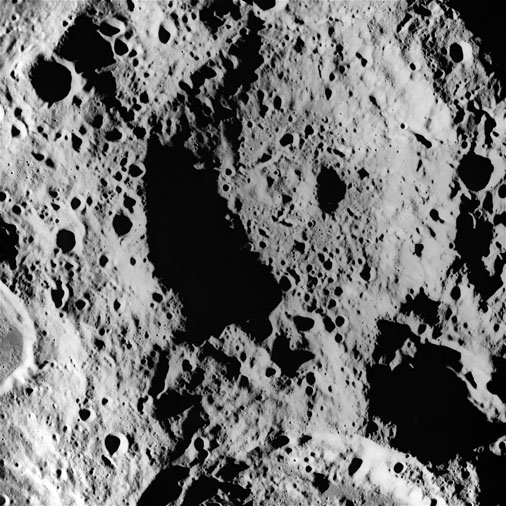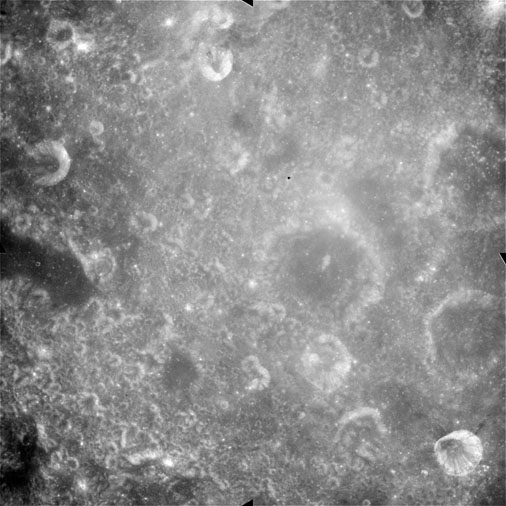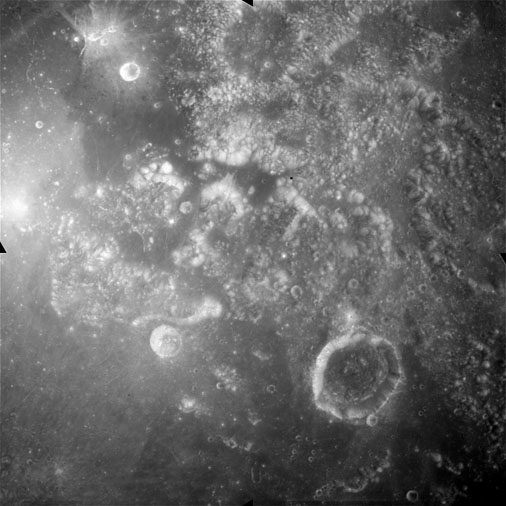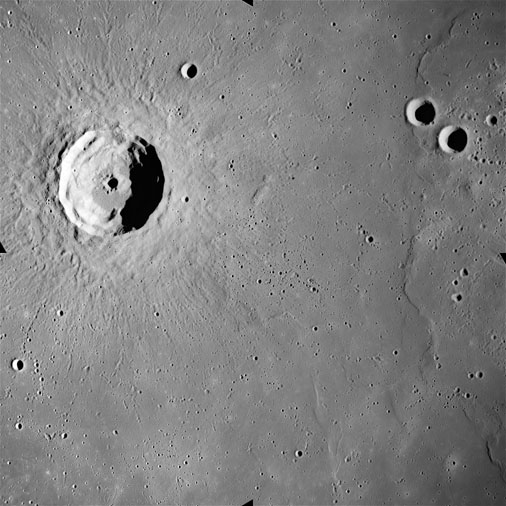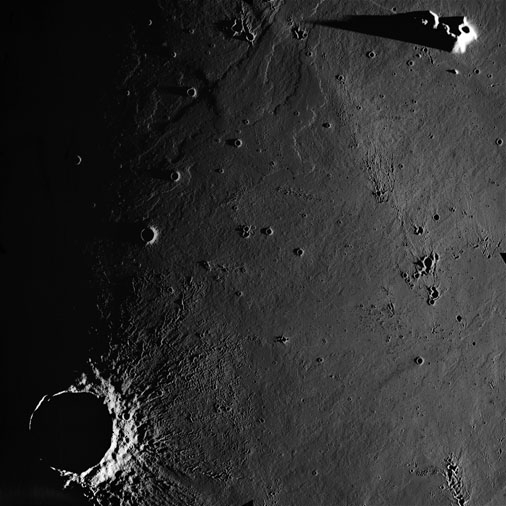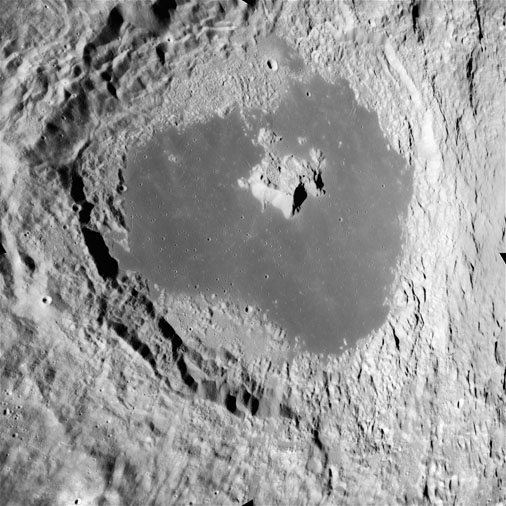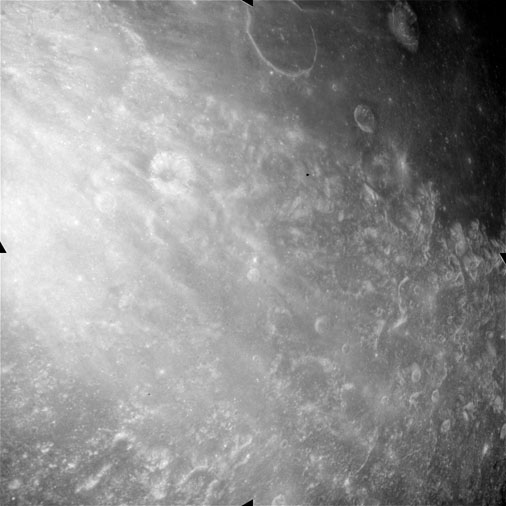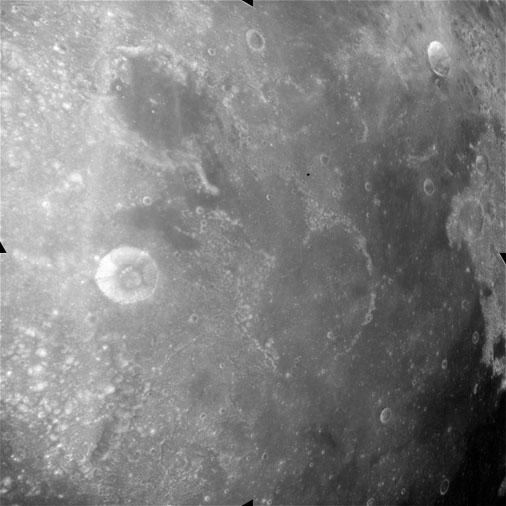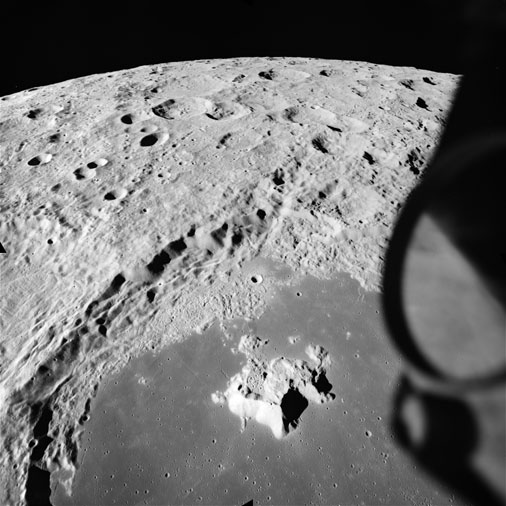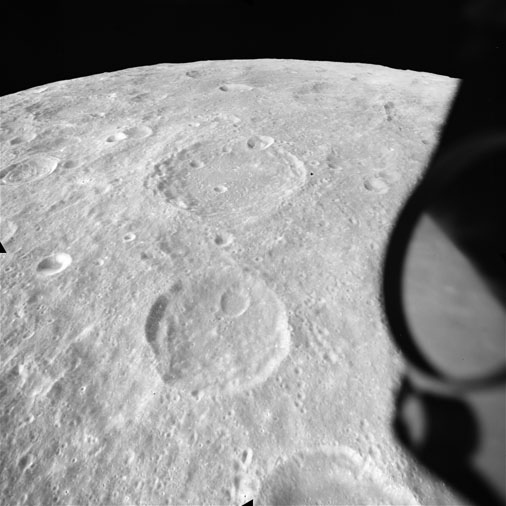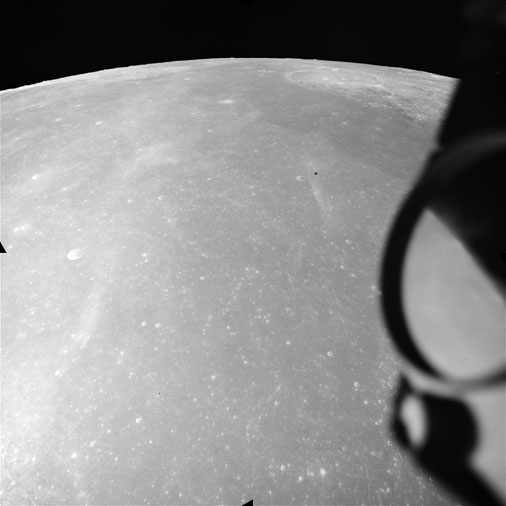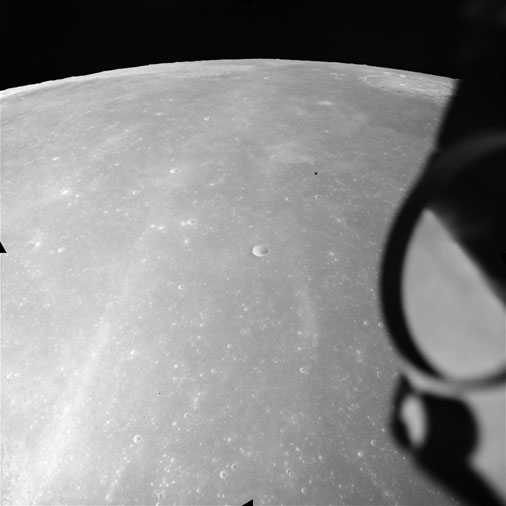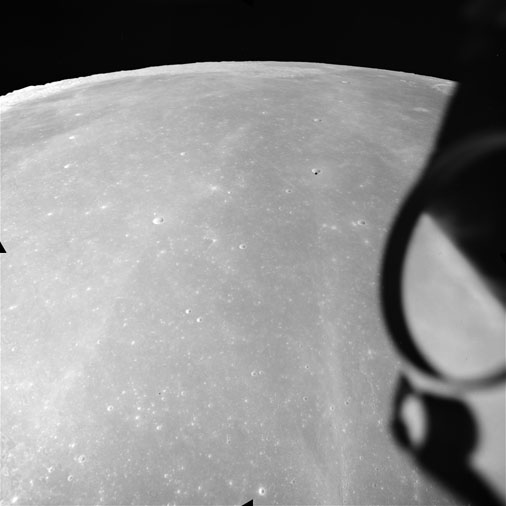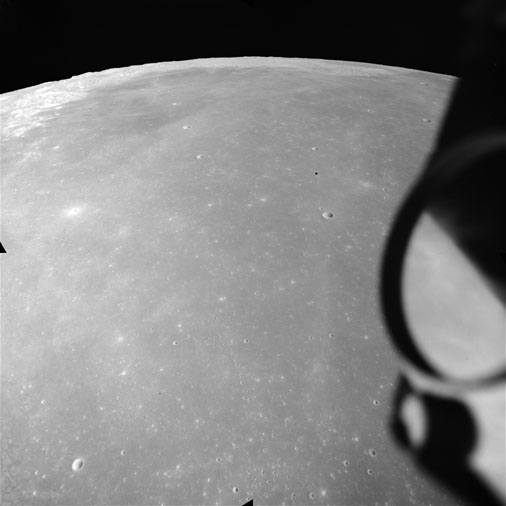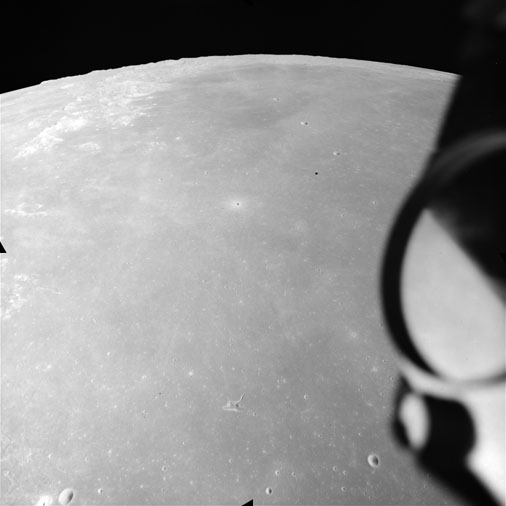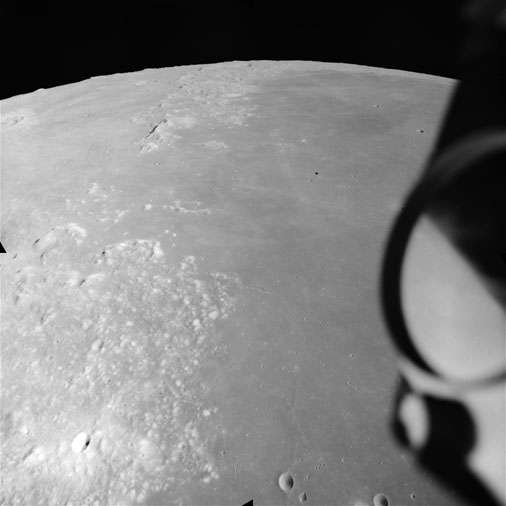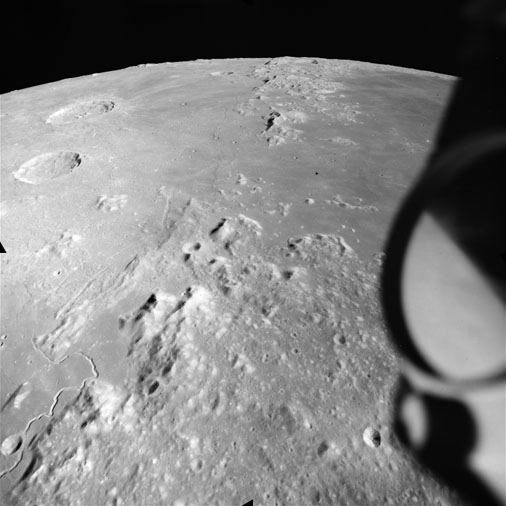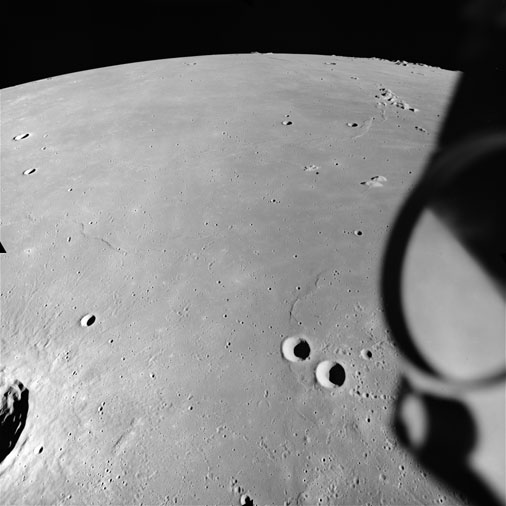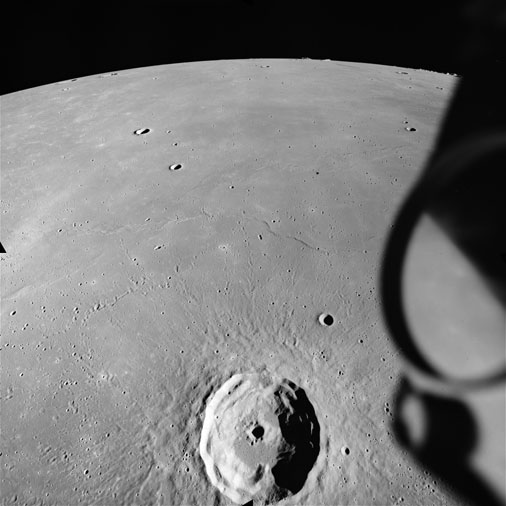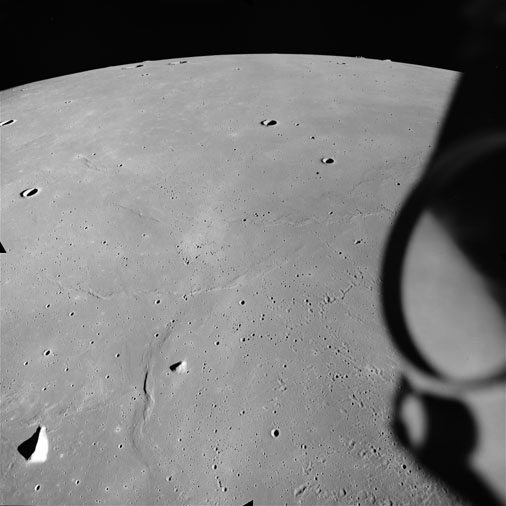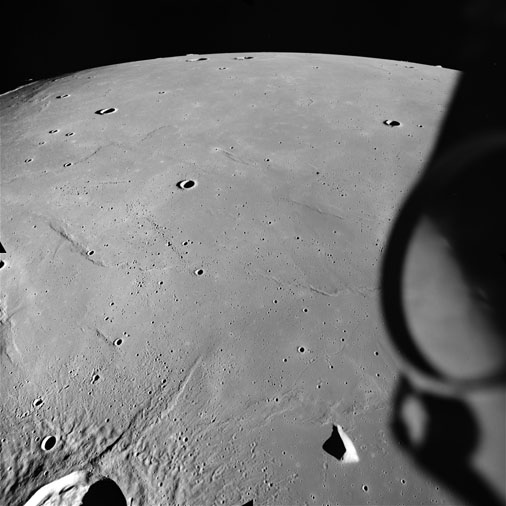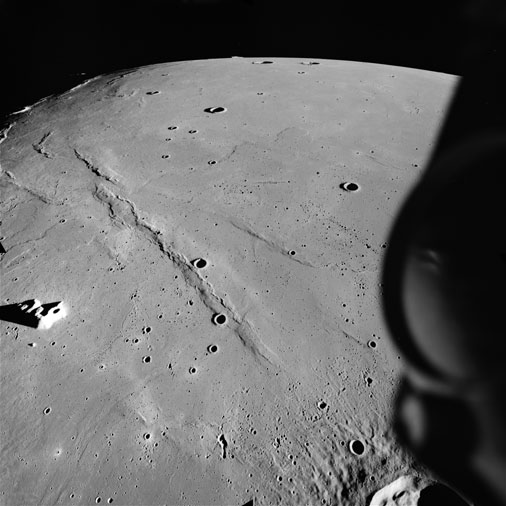This is Apollo Control at 135 hours, 58 minutes. All still going well with Falcon on the lunar surface. Crew still asleep. We've had no communications with them since they went to bed. They're due to be awakened in 2 hours, 1 minute. The Command Module Endeavour is now in its 30th revolution on the front side of the Moon and we have data from Endeavour although we have not talked to Command Module Pilot Al Worden during this pass. Endeavour's in a 65.9 by 51.6-nautical-mile orbit. It's present altitude is 63 nautical miles and its velocity, 5,324 feet per second. At 135 hours, 59 minutes; this is Mission Control, Houston.
This is Apollo Control at 136 hours, 58 minutes. All systems aboard Falcon and Endeavour still normal. We had Loss of Signal on Endeavour a few minutes ago on its 30th revolution. We're 1 hour, 1 minutes from wake-up time for the crew of Endeavour [means Falcon] at which time they;ll start preparing for their second EVA. At 136 hours, 59 minutes; this is Mission Control, Houston.
This is Apollo Control at 139 hours, 11 minutes. Dave Scott and Jim Irwin will be beginning preparations soon for the second EVA at the lunar surface. Here in the Control Center, the flight controller teams which will be active during the EVA are beginning to arrive. Flight Director Gerry Griffin preparing to relieve Flight Director Milt Windler. And Flight Director Gene Kranz has reported. He - he will be handling the Command Module during the EVA period. The CapComs will be astronaut Joe Allen for the surface exploration and astronaut Karl Henize for the Command Module. We'll continue to stand by live for further conversations between Falcon and Houston. At 139 hours, 12 minutes; this is Mission Control, Houston.
143:49:24 Worden: Okay, Houston. Endeavour's coming up over Picard, and I thought I'd just go ahead and talk while we're going over Picard. First, talking about the color variations, Picard is a slightly different color than the rest of (the) mare basin. It's - I guess what I would consider Crisium - a light brownish gray. Picard, itself, is - is - is more of a brown tone, and it has a darker halo around it. I can see some of the brown - material just on the outside of the rim; and outside of that is some darker material that gradually turns into the gray of Mare Crisium. Inside Picard, I can see - well, let's see now, let's count them - 1, 2, 3, 4, 5, 6, six distinct rings that go around the inside of Picard. And the - and the walls in Picard are very shallow. It looks like a very shallow, almost like a - a dish - kind of basin, and gently from the edges on in toward the center, and, as I say, I can count - five or six rings inside, that are all concentric with the center of the basin. And I can see some definite layering in - in the - particularly in the upper boundary of the rim.
143:52:09 Henize: Roger; we're - we're copying loud and clear.
143:52:09 Worden: And, I make the same comment about Yerkes.
Worden (continued): And I'm on beyond them now; I'm looking at Proclus now. And - may as well comment on Proclus while I'm here. Remember yesterday, we were talking about variations in the crater wall to - that - well, don't exactly know how to describe it, but there - there is a tremendous variation in the wall, which does line up with ejecta pattern. If - there's almost a straight wall on the side of Proclus that is minus an ejecta pattern. And then there is some breakthrough directly in the middle of that - of that wall, which makes Proclus looks like it's almost a circular crater. However, the - the truth is that Proclus looks like a - an elongate crater with - with one wall steeping [sic] - dipping quite steeply into the crater, and that wall is oriented perpendicular to a line bisecting the excluded zone dipping into the crater, and then right - right at the middle of that portion, it looks like there was a - a small - well, a small piece of that wall was - was also ejected, but it - it was only at the top part of that - of that fault scarp. And so, if you look at it from the right angle, you can see almost a flat plate, which looks like it's cut right into Proclus, and to the - to the north and west of that flat plate is the crater Proclus, and to the south and east is a small chunk out of the top of it that coincides with the - the - the central part of the excluded zone.
143:54:49 Henize: Roger, Al; we copy.
143:54:54 Worden: Hope you could understand all that, Karl. I had to talk fast and formulate as I went.
143:55:00 Henize: Roger, it came through loud and clear, and I think it was quite understandable. Very good.
143:55:15 Worden: Okay; I'm drawing a couple of little pictures of it to show you when I get back.
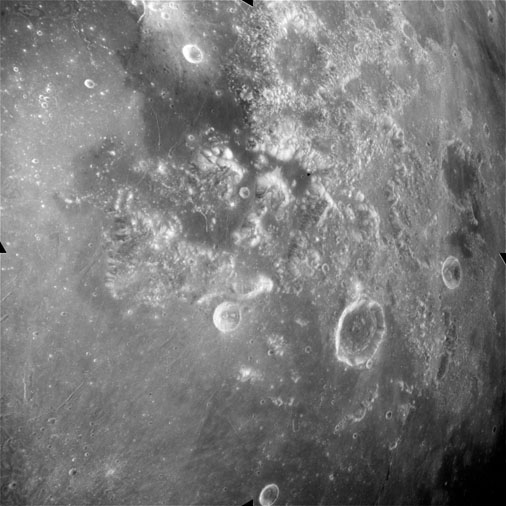
AS15-M-1403 - Metric Camera image of the eastern shore of Mare Serenitatis and Montes Taurus, including craters Clerke, Littrow, Vitruvius and Fabbroni.
(250 megapixel version),
(labelled version) - Image by NASA/ASU.
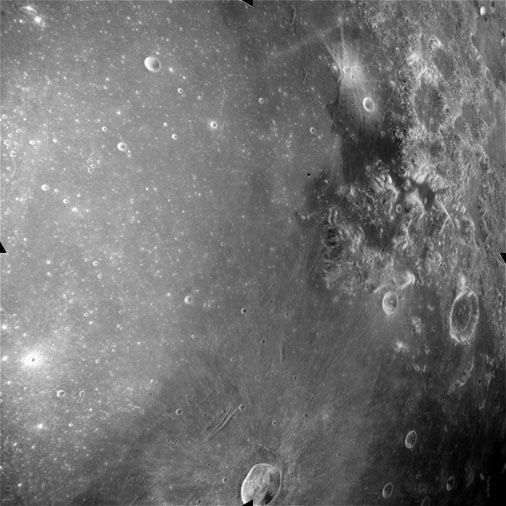
AS15-M-1405 - Metric Camera image of the eastern shore of Mare Serenitatis and its connection with Mare Tranquillitatis, including craters Clerke, Littrow, Vitruvius, Fabbroni, Dawes and Borel.
(250 megapixel version),
(labelled version) - Image by NASA/ASU.
143:55:21 Henize: Okay, Al; we have Earthshine photography coming up in about 15 minutes. I'd better give you a PAD on it, and I also have another PAD for later photography on that page - or on the following page.
143:55:35 Worden: Okay. Okay, Karl. Stand by one.
143:57:10 Worden: Okay, Houston. Go ahead with the Earthshine PADs.
143:57:13 Henize: Roger. Earthshine PAD at about 144 hours and 5 minutes in your Flight Plan; the number is 144:10:32.
143:57:29 Worden: Understand 144:10:32.
143:57:32 Henize: Roger; and on the next page, a Map Camera photo PAD; take it?
143:57:41 Henize: Start, 145:14:16; stop, 146:13:56. [Long pause.]
143:58:19 Henize: The - did the Map Camera photo PAD...
143:58:21 Worden: Okay, I have my Mapping Camera photo PAD.
143:58:26 Worden: Negative; you - you were cut out.
143:58:28 Henize: Oh, Roger. Mapping Camera photo PAD. Start, 145:14:16; stop, 146:13:56.
143:58:42 Worden: Understand. T-start, 145:14:16; T-stop, 146:13:56.
143:58:52 Henize: That's correct.
144:09:07 Henize: Al, we've got 30 seconds until the Mapping Camera comes off. And then, 1 minute later, we start revving up for the Earthshine photos.
144:09:19 Worden: Roger, Karl.
144:14:11 Henize: Okay, we start Earthshine photos in about 20 seconds.
144:14:29 Worden: Roger, Karl; understand. And, listen, since I got all the lights turned out here, how about stepping me through the Earthshine photos.
144:14:41 Henize: Roger. Okay, we're plus 4 minutes right now [on the mission timer] in 6 seconds [time]. 4 frames at 30 second intervals. [Long pause.]
144:15:17 Worden: And, Karl, I hope these all turn out, because this is the - the area on the last rev that I commented on all the lava flows, and we're right over now taking pictures.
144:15:27 Henize: Very good. [Long pause.]
144:16:07 Henize: Okay, after your fourth frame, you're going to change the shutter to 1/15th of a second. And - and then take four more frames at 30 second intervals.
144:16:17 Worden: Okay, 1/15th. [Long pause.]
144:16:34 Henize: I'm sorry; I could have been counting time for you, too. We're coming up to plus 6 minutes, which should be about the 4th frame at the old setting. We'll mark on 6 minutes.
144:16:47 Worden: Okay, got it.
144:16:49 Henize: And I'll call out times for you now, too. We go to 1/15th of a second.
144:16:55 Worden: Okay, I just took one frame at 1/15th.
144:16:58 Henize: Excellent. [Long pause.]
144:17:22 Henize: [It is now] Plus 30 seconds after your first picture.
144:17:54 Henize: Take number 3.
144:18:24 Henize: Take number 4, and change shutter setting to 1/8th.
144:18:34 Worden: Roger; 1/8th.
144:18:41 Henize: Now we're going to take 10 frames at 30 second intervals. Give me a mark on your first one.
144:18:49 Worden: Mark. [Long pause.]
144:19:23 Henize: Time for number 2.
144:19:28 Worden: On. [Long pause.]
144:19:53 Henize: Take 3. [Long pause.]
144:20:23 Henize: Take 4. [Long pause.]
144:20:52 Henize: Take number 5. [Long pause.]
144:21:22 Henize: Take number 6. [Long pause.]
144:21:52 Henize: Take 7.
144:21:57 Worden: Roger; take 7, and I just went past the spacecraft terminator.
144:22:07 Henize: Say again? Roger; we copy.
144:22:13 Worden: Okay, I just went by spacecraft terminator.
144:22:17 Henize: Roger; we copy.
144:22:22 Henize: Take 8. [Long pause.]
144:22:52 Henize: Take number 9. [Long pause.]
144:23:22 Henize: Take number 10. Change the shutter to 1/500th, cover the lens, and cycle one frame.
144:23:40 Worden: Okay; thank you.
144:25:20 Henize: Okay, Al, in case you don't have your Flight Plan handy, we need to start a "P20 plus-X Forward" in a couple of minutes, and that will be followed by deploy of the Gamma-ray boom.
144:25:39 Worden: Roger; Karl. I'm with it.
144:28:43 Henize: Al, are we in time to get a mark from you when you start the Gamma-ray boom [going] out?
144:28:51 Worden: Roger. I'm ready now. Gamma-ray boom going out.
144:28:57 Henize: Thank you.
144:30:03 Henize: Hey, time for exercise, Al. [Long pause.]
144:30:18 Worden: Yeah, I guess that's right, Karl.
144:31:41 Worden: Okay, Karl.
144:31:42 Worden: Mark; on the Gamma-ray boom.
144:31:45 Henize: Thank you.
144:34:13 Henize: Al, you may be interested to know that the Rover boys are up on the slopes of Hadley Delta now. They got themselves up to - to an area where there is considerable angle on the hillside, I'd guess 20, maybe almost 30 degrees. And it's still very fine soil, which acts a lot like snow. And you should have saw Dave about 5 minutes ago; took a beautiful spill in it.
144:34:42 Worden: Tell them to be careful.
144:41:52 Henize: Al, as you go around the corner, all your systems are looking good.
144:42:00 Worden: Roger, Karl.
144:42:03 Henize: See you on the other side.
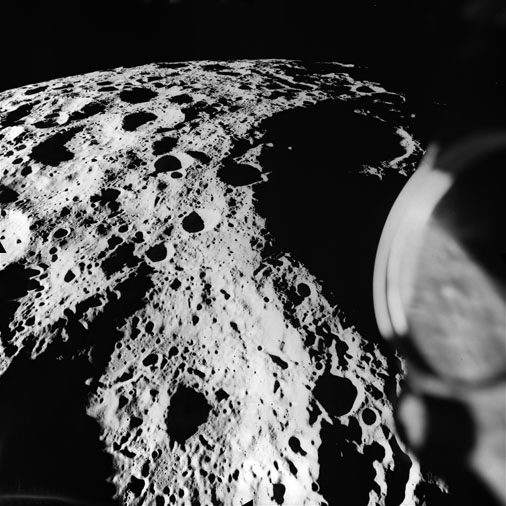
AS15-M-1432 - North-facing oblique Metric Camera image of the far-side terminator including craters Levi-Civita, Denning and Isaev. Large crater, Gagarin, is in shadow. Taken at about 145:15 GET.
(250 megapixel version),
(labelled version) - Image by NASA/ASU.
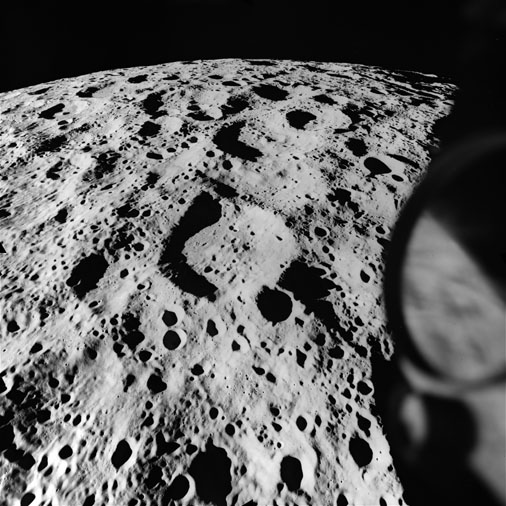
AS15-M-1435 - North-facing oblique Metric Camera image of far-side craters Pirquet, Denning, Bondarenko and Chauvenet. Taken at about 145:16 GET.
(250 megapixel version),
(labelled version) - Image by NASA/ASU.
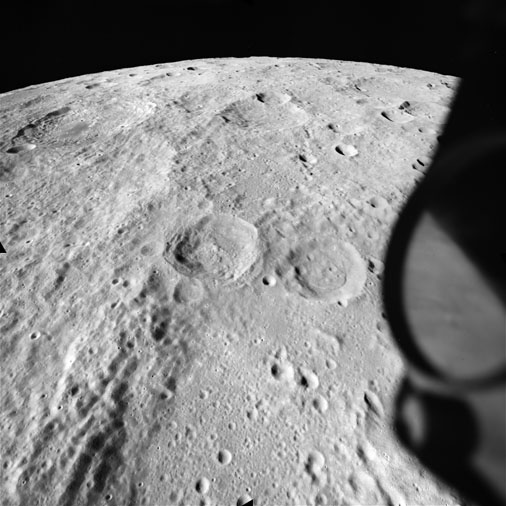
AS15-M-1448 - North-facing oblique Metric Camera image of the northwest quadrant of crater Fermi, including craters Delporte, Lütke, Langemak, Danjon and Perepelkin. Taken at about 145:22 GET.
(250 megapixel version),
(labelled version) - Image by NASA/ASU.
145:29:44 Henize: Endeavour, this is Houston. How do you read?
145:29:50 Worden: Hello, Houston; Endeavour. Reading you loud and clear.
145:29:56 Henize: Same here. How goes it up there?
145:30:01 Fine, Karl. And I got a couple of comments on Tsiolkovsky, in addition to what I said last rev.
145:30:09 Henize: Go ahead, we're ready to copy.
145:30:14 Worden: Okay, talk - discussing the - the flow in crater Waterman, south of Tsiolkovsky, I guess what I said before still applies. The - what looks like on a map is the channel between Waterman and Tsiolkovsky is, in fact, too high for anything to flow between the two. There's - there's definitely some elevation there. However, looking at it this time, it's pretty plain that that channel - or gully, or whatever you call the breach in - in Tsiolkovsky's wall there between Waterman and Tsiolkovsky is caused by a graben-like fault system. There are two faults that run through there, and they run almost north and south right towards the central peaks, diverging - the one - the one on the west side, is slightly - is angled slightly to the northwest, but the other one goes almost directly north. And the source of the lava flow in Waterman appears to be high in the - in the wall of Waterman, on the north edge, right where the fault zone crosses the - the rim of Waterman.
145:31:30 Henize: Roger, Al. We copy.
145:31:35 Worden: Okay, now there are a couple of other small - small craters around Tsiolkovsky. Particularly, one on the north side, on the northeast corner, the first large crater that you see there, has a very distinctive lava flow or some kind of flow down in the crater. And that flow also originates up in the corner or up in the - in the high towards the rim of that particular crater, where there's some contact between the - the Tsiolkovsky rim and the rim of that small crater.
145:32:31 Worden: Now again, I saw no evidence of - of any kind of a rock slide to the south of Tsiolkovsky, but the one on the west there is, looks - you know every time I go over it - it certainly confirms my opinion that that's a rock slide. The lineaments, the way the - the thing ended, the lobate - the lobate tongues on it and everything. It's interesting that the rim of Tsiolkovsky, on the west side there, is - different from - across that fault zone - is quite different from [what] it is around the rest of the crater, maybe suggesting that that [is] the source of the flow. The rim seems to be not as sharply defined; it's lower and appears to be out from the edge of the basin more than the rest of the - of the boundary or the rest of the ejecta pattern around Tsiolkovsky, and there, where that very steep, almost smooth scarp is, on the west of Tsiolkovsky, seems to be the - the point at which it starts.
145:33:48 Brand: Al, Vance here. You have any comments on the rim of the north, northwest side, where you, [cough] it appears the rim might have slipped or - or you have a - a fault which shows the displacement?
145:34:07 Worden: Oh, yes, Vance, very definitely. There are a couple of fault zones, through there, and you can - you can see the displacement quite clearly from the air. The one, the fault zone between Waterman and Tsiolkovsky, is a - is a lot more subtle, but I - but I'm quite sure that, that's what's going on there. But the one on the west side is - is very clear. That - that's true.
145:34:29 Brand: Al, we'd like to have High Gain, Auto.
145:34:37 Worden: And, Vance, another comment about that. You got High Gain, Auto, by the way. Another comment about that, where that fault zone appears on the west side, there's much less mass wasting into the interbasin of Tsiolkovsky, than there is around the rest of the - of the crater. Most of that mass wasting seems to taken place outside the crater.
145:35:00 Brand: That's an interesting observation.
145:36:09 Henize: Al, Vance and I called up to your apartment a little while ago. Your folks are there. And I guess, as you know, they've got a squawk box look - listening in...
145:36:19 Worden: Oh, great.
145:36:20 Henize: ...listening on our loop with great interest. Except when you go behind the Moon, then they - then they watch the other show that's taking place on the surface. They said to say "Hello." And, they sound like they're having a good time up there.
145:36:36 Worden: Very good. Very good. Hello, folks.
145:40:19 Henize: Al, in 30 seconds we're coming up to a Pan Camera operation Mode, Standby; Power, On.
145:45:36 Henize: Al, while we're waiting for that Pan Camera off cue, I've got a couple of photo PADs - a couple of Flight Plan updates here for you, if you can copy them.
145:45:51 Worden: Okay, Karl; go ahead.
145:45:52 Henize: Okay. 148 hours and 0 minutes, they would like to have you get some good shots on those lava flows you saw over in Imbrium. And the recommendations that we have are as follows: CM3, EL, 250 mm lens, CEX, f5.6, 1/125, infinity, 5 frames at 10 second intervals. Recommend convergent photos starting at TCA minus 30 seconds. The aim point is up to you. Magazine Q, and record frame number. And then on the same page, 148 hours and 18 minutes, we don't need to do that P52 there, because the platform looks very good.
145:47:15 Worden: Okay, Karl. Understand photos of the lava flows in Imbrium that we noted on the last rev, that'd be CM3/EL/250, CEX, f5.6, 1/125, infinity, 5 frames in 10 seconds, use magazine Q, and try and get convergent stereo starting at TCA minus 30.
145:47:38 Henize: That's correct.
145:47:42 Worden: And, also, delete the P52.
145:47:44 Henize: Roger. [Long pause.]
145:48:01 Worden: Karl, while we're going over Crisium here. Looking down at Picard, at Peirce and at Lick, I noticed that all of those craters, that's - that's Lick Delta by the way, Lick Delta, Picard, and Peirce, all look like - they're - they're all about the same. They all have the same ring structure, all have the same low rims. The rims are - are - are what look like very shallow [elevation] compared to the rims on the other craters I've seen around. And, also, they all have a slightly darker halo effect around the - the entire crater. But the - the color difference is very subtle.
145:48:48 Henize: Roger, Al. As I look on the map here, they look like they might have been old craters flooded by the mare. Is that - does that seem feasible to you as you look at them?
145:49:00 Worden: No, it doesn't to me, Karl. They're a quite different texture inside, and you can see the ring structure clear down to the bottom of the crater. So I would say that they were - they were - they were not flooded craters.
145:49:11 Henize: Roger. Okay. [Long pause.]
145:49:52 Henize: Hey, Al. Relevant to your observations coming up on Littrow here, Farouk [El-Baz] has asked whether the comments that you made previously about Littrow, seeing a - a mantling of dark material everywhere with a few puddles in the valleys, whether that same comment would - pertain to Sulpic - Sulpicia - yes...
145:50:15 Speaker (in Mission Control): Sulpicius Gallus?
145:50:16 Henize: ...Sulpicius Gallus. Or do you...
145:50:18 Worden: ...yes, Okay. Sulpicius Gallus. Certainly, Karl.
145:50:21 Henize: Right. Do they - do they look like very similar areas, or are there some contrasts there?
145:50:28 Worden: Okay. I'll let you know when I get there. Unfortunately, I think I'm not - I think I'm going to be out of attitude to take a look at Sulpicius Gallus.
145:50:35 Henize: Okay. That's for future reference then.
145:50:40 Worden: Yes, okay. But I'll - if - if I can see across Serenitatis there, I'll - I'll give you a hack on that.
145:51:05 Henize: Okay. I guess I should keep quiet a while and let you look at Littrow coming up in about a minute. [Long pause.]
145:51:55 Henize: Al, we can have Pan Camera Power, Off now.
145:52:01 Worden: Okay. Pan Camera Power, Off.
145:57:05 Worden: Houston, Endeavour.
145:57:07 Henize: Go ahead, Endeavour.
145:57:12 Worden: Okay. Karl, I can give you at least a partial answer on that question. The - the coloration that seems to be continuous from Littrow all the way around through Sulpicius Gallus is the middle color. It's slightly darker than the rest of the mare basin [means surface] itself and not quite as dark as some isolated or localized areas within the Littrow area.
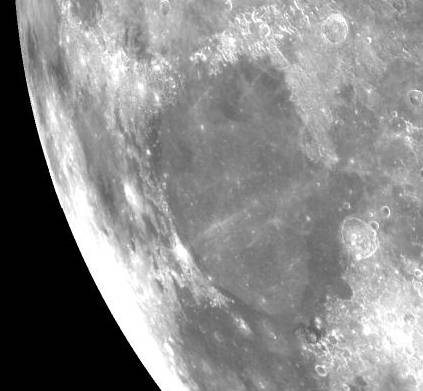
Mare Serenitatis seen from over Moon's north pole.
Worden (continued): Now, those - those localized areas in the Littrow area were the areas in which I saw what appeared to be some ver - rather prominent, distinctive cinder cones, with their own respective dark halo. And it seemed to be the same darkness as the rest of the material in local areas within the Littrow area. In other words, there are - there are three variations of color. There are three tones of color in the Littrow area. The darker tones are associated with - the - with the lowland areas, like the valleys and like - down on just the edge of the mare surface. Then there's a lighter tone, which seems to be associated all the way around the - the - the ring or the rim of Serenitatis from Littrow all the way around through Sulpicius Gallus. And I don't see any other colors around Sulpicius Gallus, except that one. And they seem to encompass the area between the first wrinkle ridge and - and the contact between the mare basin [means surface] and the front there. Sort of like between the archuan [means arcuate] rilles and the first set of wrinkle ridges in the Serenitatis basin [means surface].
Worden (continued): And then, As I'm looking at - right now, sorry I interrupted myself there. But looking right now at Bessel, and Bessel has some very distinct layering. In - in fact, Bessel looks like some craters, some volcanic type craters we've seen on Earth, where, to get alternate lava flows and sedimentary kind of rocks, then the lava flows stick out in the edge of the wall. In Bessel, about a third of the way down, there is a very distinct ledge that can - that can be seen all the way around Bessel. The rest of the - of the crater wall appears fairly smooth; but about a third of the way down is a - is a ledge.
146:00:15 Henize: Roger, Al, you're...
146:00:16 Worden: And that ledge looks like it's caused by a - a harder material.
146:00:21 Henize: Roger. You're coming through loud and clear. [Long pause.]
146:00:43 Henize: Do any of the other craters around that area, around Bessel, show the same sort of interior ledge like that?
146:01:06 Worden: Well, unfortunately, Bessel is the only one of that magnitude around - around that particular area. And I don't see any other craters that appear to go down below - whose depth appears to go down below the depth of the rim in Bessel.
146:01:15 Henize: Right. I - the only two I see possible here are Bessel E and Sulpicius Gallus; and I guess they might not go that deep even so. [Long pause.]
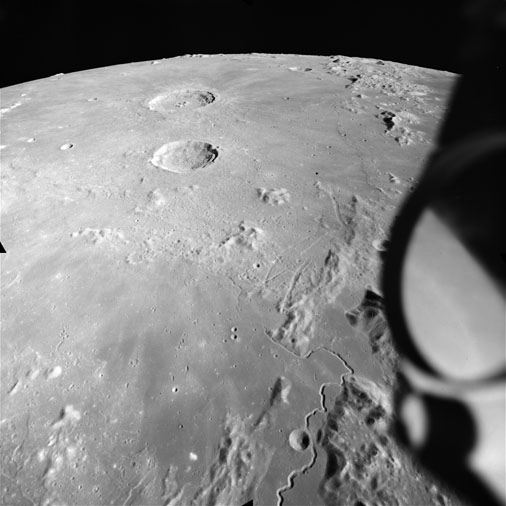
AS15-M-1538 - North-facing oblique Metric Camera image of eastern Mare Imbrium including craters Aristillus and Autolycus. Taken at about 146:01 GET.
(250 megapixel version),
(labelled version) - Image by NASA/ASU.
146:01:51 Henize: Hey, Al, have you ever looked at Autolycus and Aristillus with the thought in mind of determining which overlaps the other; which is the younger?
146:02:08 Worden: No, I haven't yet, Karl. Maybe this is a good time to do it.
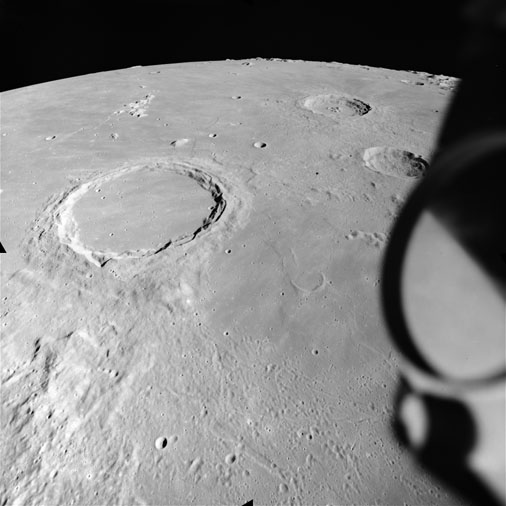
AS15-M-1541 - North-facing oblique Metric Camera image of easter Mare Imbrium including craters Archimedes, Aristillus and Autolycus. Taken at about 146:03 GET.
(250 megapixel version),
(labelled version) - Image by NASA/ASU.
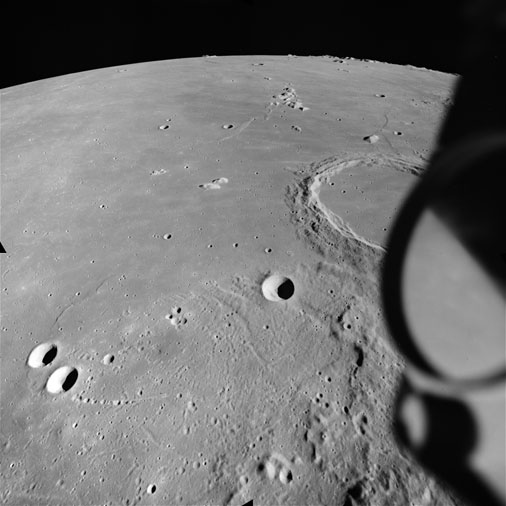
AS15-M-1544 - North-facing oblique Metric Camera image of eastern Mare Imbrium including craters Archimedes, Feuillée, Beer and Bancroft. Taken at about 146:04 GET.
(250 megapixel version),
(labelled version) - Image by NASA/ASU.
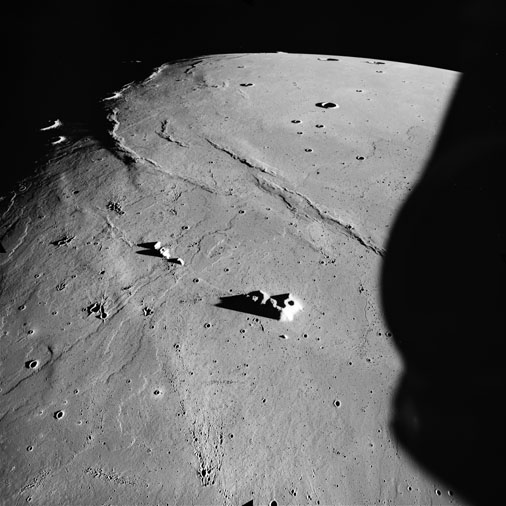
AS15-M-1556 - North-facing oblique Metric Camera image of eastern Mare Imbrium including Mons La Hire and the wrinkle ridges, Dorsum Zirkel and Dorsum Heim. Taken at about 146:12 GET.
(250 megapixel version),
(labelled version) - Image by NASA/ASU.
146:13:01 Henize: Endeavour, we have the Mapping Camera coming Off in just one minute.
146:13:07 Worden: Roger, Houston.
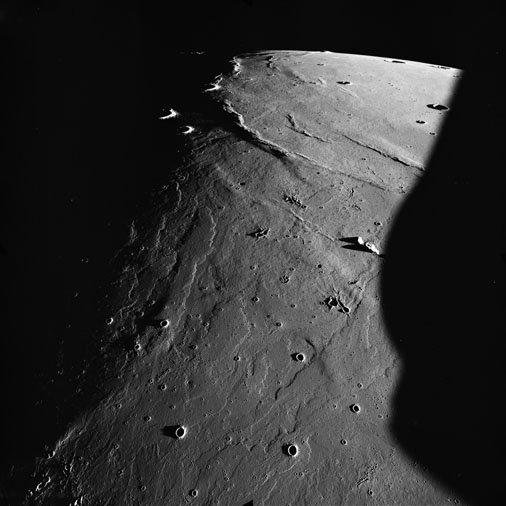
AS15-M-1558 - North-facing oblique Metric Camera image of eastern Mare Imbrium and the sunrise terminator. The ancient lava flows that formed the mare are apparent. Taken at about 146:13 GET.
(250 megapixel version),
(labelled version) - Image by NASA/ASU.
146:18:12 Henize: Al, I have a couple of comments on the water dump coming up in - 10 or 15 minutes.
146:18:23 Worden: Okay. Go ahead.
146:18:24 Henize: We'd like to dump down to 10 percent. Stop at 10 percent. And they say that the dump will probably take about 8 minutes, so about 6 minutes after you start dumping, keep an eye on it and stop at 10 percent. And also, they'd like for you again to - to make an observation of the particle cloud at sunset and sunrise terminator, if you would, please.
146:18:51 Worden: Okay. Will do. And I understand you just want me to dump down to 10 percent.
146:18:56 Henize: That's correct. And over at 146:33, where you have a "Gamma-ray Gain Step Shield, On, [Center]," we'd like you to take - to make one step increase in - in gain there. That's up momentarily, once.
146:19:20 Worden: And that's at what time?
146:19:23 Henize: That's over at 146:33, where you - they want you to put Shield, On [center]. After you have it on center, take it up once momentarily for one step increase in gain, and then leave it on center.
146:19:46 Worden: Okay; Understand. Gain Step Shield, On and - go one step up, and then leave it Shield, up.
146:19:54 Henize: That's affirmative.
146:21:51 Henize: Okay, Endeavour. We're coming up to Gamma-ray Gain Step, Shield, Off in - in about 5 seconds.
146:29:56 Henize: Al, a bulletin from Hadley Rille, says that...
146:30:00 Worden: ...from what?
146:30:04 Henize: Go ahead. [Long pause.]
146:30:29 Henize: Go ahead, Al. We're listening.
146:30:36 Worden: Karl, I didn't call. I'm waiting on you.
146:30:39 Henize: Oh, Roger. A bulletin from Hadley Rille - the crew finished their exploration of the Apennine front. They got over to Spur Crater and actually into Spur Crater, found there a large block of rock, which probably is a really true sample of the Apennine Front and got some good samples there. And, now they're driving back down by the South Complex and they're digging some samples around Dune Crater.
146:31:16 Worden: Very good. Sounds like they're doing quite well down there.
146:31:20 Henize: Yes, indeed.
146:31:25 Worden: I think we're going to give lots of people lots of things to do for a while.
146:31:30 Henize: You said it.
146:32:44 Henize: Okay, Al. In about 20 seconds, we have the Gamma-ray operation coming up.
146:32:53 Worden: Roger, Karl. [Pause.]
146:33:07 Worden: Okay. You've got the Gain Step, one step, then it's back at Shield up.
146:33:14 Henize: Very good.
146:39:56 Henize: Al, this is Houston. All of your systems are looking in great shape as you go around the corner.
146:40:05 Worden: Okay, Karl. And we're looking okay up here. Getting ready to do the gegenschein calibration.
146:40:13 Henize: Very good.
147:29:54 Henize: Endeavour, this is Houston. How do you read?
147:30:00 Worden: Hello, Houston; Endeavour. Loud and clear.
147:30:03 Henize: Good to hear your cheery voice. How is everything up there?
147:30:09 Worden: Yes, just fine. It took us a little longer to lock up that time.
147:30:17 Henize: Yes. A couple of minutes, but it still wasn't bad.
147:30:39 Worden: And, Karl, on the waste water dump, I overshot 10 percent, just a little bit, but I'm reading - I'm reading about 10 percent now.
147:30:48 Henize: How much was that?
147:30:54 Worden: I'm reading 10 percent.
147:30:55 Henize: Roger. Reading 10 percent now. I copy that. [Long pause.]
147:31:26 Henize: Al, we'd like to have High Gain [Antenna], Narrow and Auto.
147:31:50 Worden: Okay, Houston. You got it.
147:31:52 Henize: Very good. Thank you.
147:32:05 Worden: And, one other thing, Karl. The attitude change from the gegenschein calibration attitude to plus-X forward SIM attitude was pretty squarely in the middle of gimbal lock. And I had to do some maneuvering to get around it, using a little extra fuel. You might run that back through with the FAO.
147:32:30 Henize: Roger. We copy. [Long pause.]
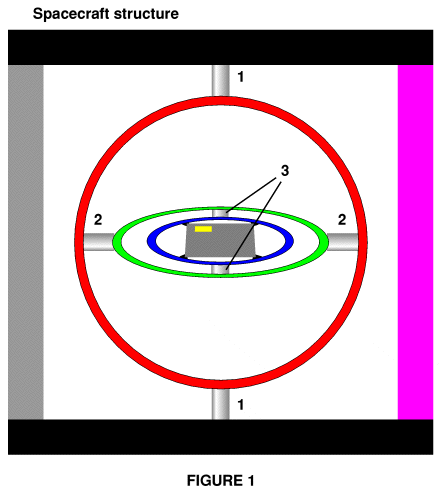
Gimbal Lock Figure 1
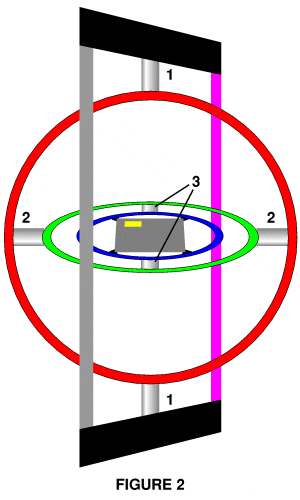
Gimbal Lock Figure 2
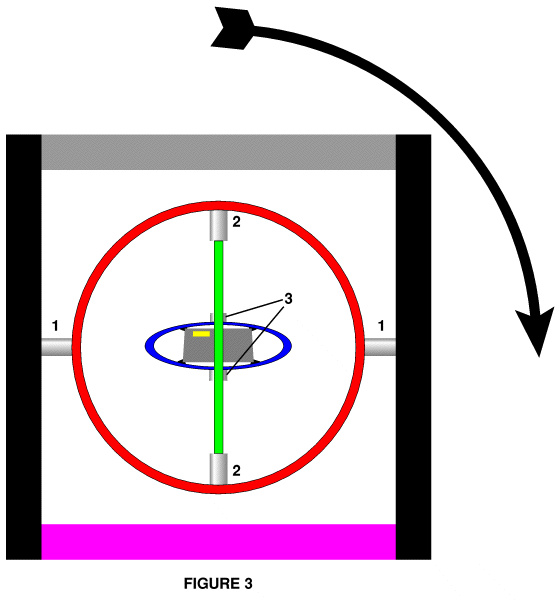
Gimbal Lock Figure 3
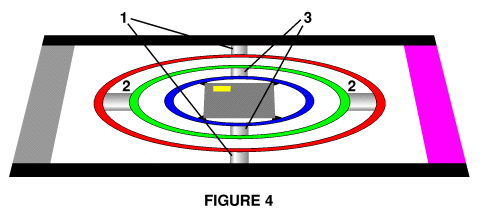
Gimbal Lock Figure 4
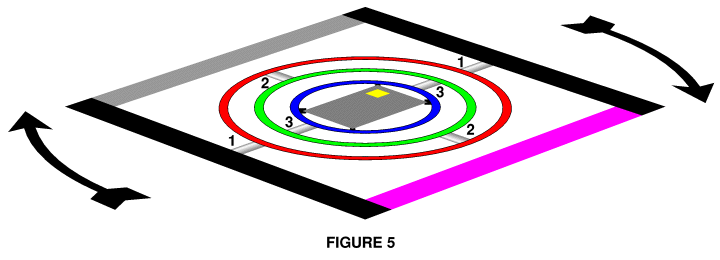
Gimbal Lock Figure 5
147:32:52 Henize: Al, still a little trouble on the High Gain. Let's go Wide Beam for a second or two and back to Narrow. [Long pause.]
147:33:57 Henize: Endeavour, let's go back to Reacq.
147:35:14 Henize: Al, we'd like to go Pitch, minus 11, Yaw 12, without changing the mode switch.
147:35:25 Worden: Understand; minus 11 and 12.
147:35:28 Henize: Affirmative.
147:36:48 Henize: Wide - Al, we need to go to Wide for a couple of seconds and then back to Narrow. [Long pause.]
147:37:45 Henize: Endeavour, could we have Wide Beam again for a couple of seconds and then Narrow. [Long pause.]
147:38:37 Henize: Endeavour, this is Houston. How do you read?
147:38:44 Worden: Houston, I'm reading you loud and clear, 5 square.
147:38:48 Henize: Good. Sorry about all of this High Gain switching problem. We're - we'll try to get it squared away - away real quick. I'll let you get back to your parsley soup.
147:39:05 Worden: Okay. I was just getting it out.
147:39:17 Worden: And, Karl, you'll be interested to know I had a very good exercise period this time.
147:39:22 Henize: Very good. Glad to near it.
147:42:46 Henize: We're all squared away on the High Gain now, Al. Thank you.
147:42:53 Worden: Okay, Karl. Was there a problem associated with my gear, or with yours?
147:43:08 Henize: We sus - we suspect that there was some problem about the new attitude, and we were getting some sort of reflection off your skin up there.
147:43:23 Worden: I see. Okay. [Long pause.]
147:44:25 Henize: Endeavour, we'd like to have High Gain [Antenna], Auto.
147:44:36 Worden: Okay. You got Auto.
147:55:50 Worden: Houston, Endeavour.
147:55:56 Henize: Endeavour. Go ahead.
147:56:01 Worden: Okay. While I'm trying to get a bite of lunch here, I thought I'd just tell you that after the dump, the same thing happened - the same kind of cloud, the same kind of particles that - that I described yesterday. And they've just about - they've just about dispersed now. Well, you know, Karl, the interesting thing, I guess I hadn't thought about it before, but when you're sitting up here looking at the surface through one window, it's just pitch black out the other windows. So you go from a very bright scene in one window to a black in the other.
147:56:36 Henize: Yes. So, actually out - out the dark window...
147:56:38 Worden: [Garbled
147:56:39 Henize: Out the dark window, you are still able to see particles?
147:56:42 Worden: Yes, I see particles; there's no cloud now.
147:56:48 Henize: You - you did see...
147:56:49 Worden: You could until just a few minutes ago, and the particles dissipated rather quickly; and now I don't see any particles out that window.
147:56:59 Henize: Roger. We copy.
147:58:41 Henize: Al, another bulletin from the lunar surface. The fellows have been back at the LM for some time and working again on the ALSEP. And the problems they had with the drill, they're trying to catch up with now. And yesterday they got in one of the heat sensors and then had trouble finding the time to get in the second one. But they did get the second one in today, and I guess now they're going to go after the core - the core drill sample.
147:59:22 Worden: Sounds like they're pretty busy down there, Karl.
147:59:25 Henize: Yes, they are having a good time there, all right.
147:59:33 Worden: Well, good for them. I'm having a hard time keeping my lobster bisque in the bag up here.
147:59:39 Henize: Hey, that sounds like a tough life you've got there. [Long pause.]
148:00:49 Henize: I just stopped to look at the clock, Al, and I see that the [Imbrium lava] flow photos are coming up on us almost immediately, if you'd like to take them.
148:02:23 Henize: As I look at the Flight Plan, I had that marked at 148 hours and 0 minutes. They must have given you a 5 minute pad[ding] there. [meaning extra time, not PreAdvisory Data] As I see your position on the Moon, you've got a while before you get there. Is that correct?
148:02:40 Worden: Right, Karl. That's the way it looks to me.
148:02:43 Henize: I have you coming up on Hadley, right - Well, you just passed Hadley, I guess.
148:02:50 Worden: Yes, that's right. I'm just going over Archimedes right now.
148:02:53 Henize: Righto.
148:06:47 Worden: Karl, Endeavour. Just for your information, at present time I'm right over Timocharis, and Lambert's coming up on - the - on the - it's just to the south of me - with Lambert R a very subdued ring just to the - to the south of Lambert. And the photos I want to take are over around the area of Mount La Hire and La Hire Rilles, a little bit west of Lambert.
148:07:20 Henize: We copy that.

AS15-M-1541 - North-facing oblique Metric Camera image of easter Mare Imbrium including craters Archimedes, Aristillus and Autolycus. Taken at about 146:03 GET.
(250 megapixel version),
(labelled version) - Image by NASA/ASU.
148:07:21 Worden: And, as a matter of fact, I have - Mount La Hire seems to be in view now and looks like I'm heading right at it.
148:07:33 Henize: Hey, as I look at the map here, it looks like about three - three hills with a crater in the top of each - look like volcanoes here although this map is lousy from that point of view. What do they look like to you?
148:07:51 Worden: Well, I can see a - the - the - they're a chain of hills - ridges, and I can't see much more than that from here right now.
148:09:37 Worden: Okay, Karl. If you're following on the map, I'm right south of the intersection of the La Hire Rilles and the wrinkle ridge [Dorsum Zirkel] that runs off to the northwest there, just by Mount La Hire. In fact, I'm directly over Mount La Hire now, and it looks like there's a volcano in - or not a volcano, but a crater, in the top of the western-most hill.
148:10:09 Worden: And I'm starting to take some pictures to the west now.
148:10:13 Henize: We copy.

AS15-M-1556 - North-facing oblique Metric Camera image of eastern Mare Imbrium including Mons La Hire and the wrinkle ridges, Dorsum Zirkel and Dorsum Heim. Taken at about 146:12 GET.
(250 megapixel version),
(labelled version) - Image by NASA/ASU.
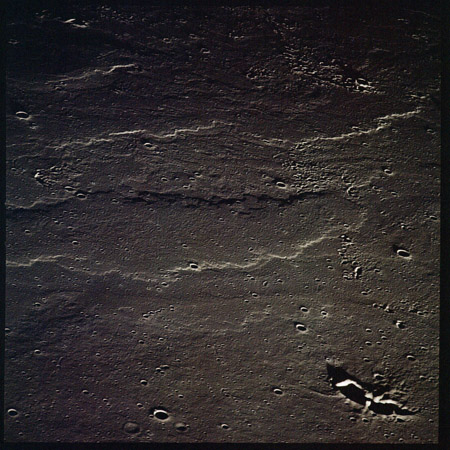
AS15-96-13023 - Lava flows on Mare Imbrium - Image by NASA/Johnson Space Center.
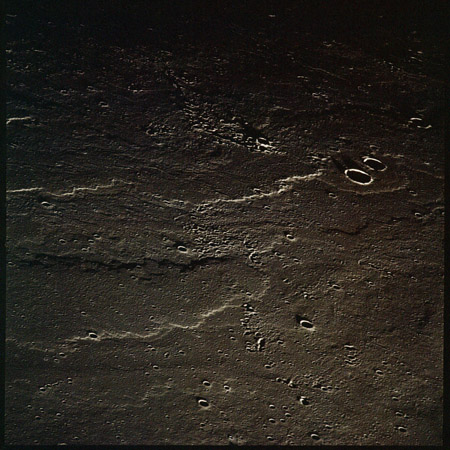
AS15-96-13024 - Lava flows on Mare Imbrium - Image by NASA/Johnson Space Center.
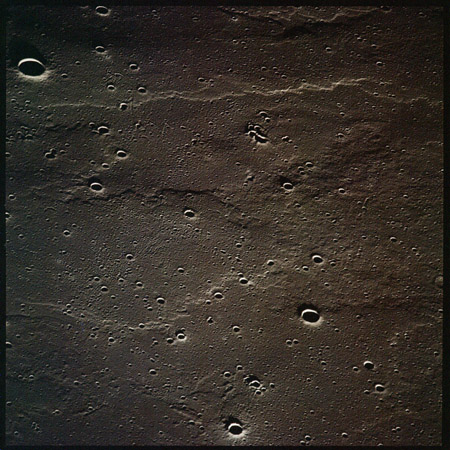
AS15-96-13025 - Lava flows on Mare Imbrium - Image by NASA/Johnson Space Center.
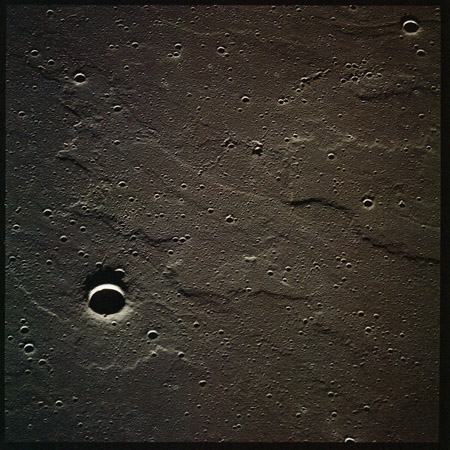
AS15-96-13026 - Lava flows on Mare Imbrium - Image by NASA/Johnson Space Center.
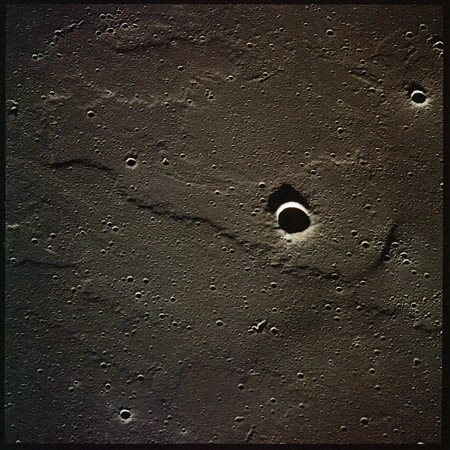
AS15-96-13027 - Lava flows on Mare Imbrium - Image by NASA/Johnson Space Center.
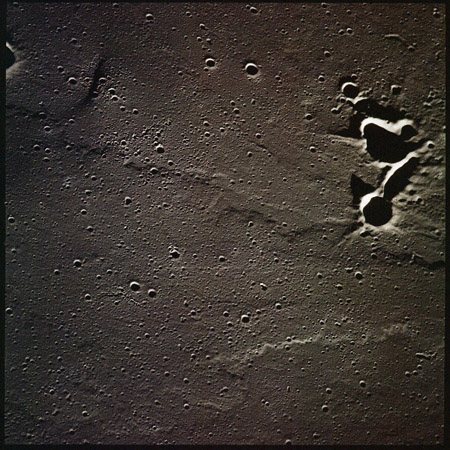
AS15-96-13028 - Lava flows on Mare Imbrium - Image by NASA/Johnson Space Center.
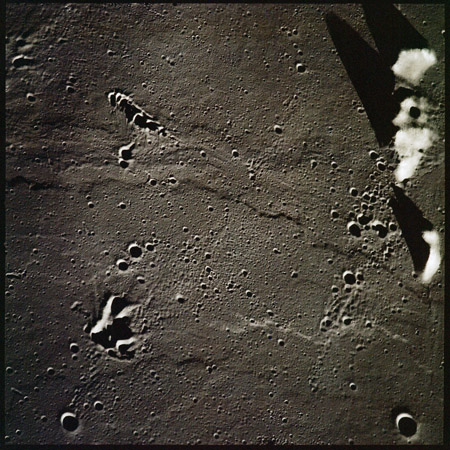
AS15-96-13029 - Lava flows on Mare Imbrium - Image by NASA/Johnson Space Center.
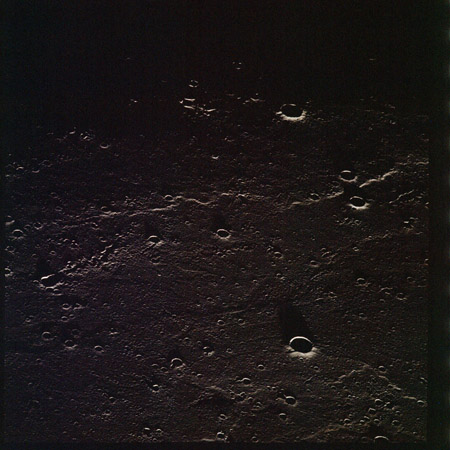
AS15-96-13030 - Lava flows on Mare Imbrium - Image by NASA/Johnson Space Center.
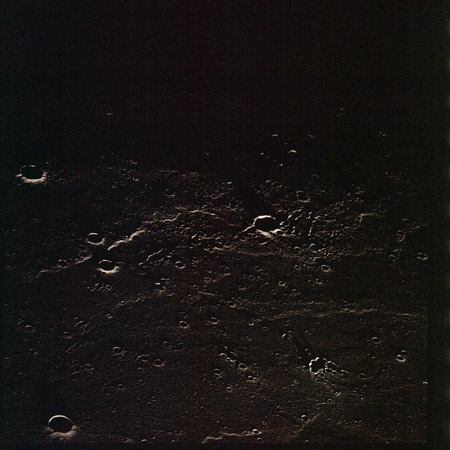
AS15-96-13031 - Lava flows on Mare Imbrium - Image by NASA/Johnson Space Center.
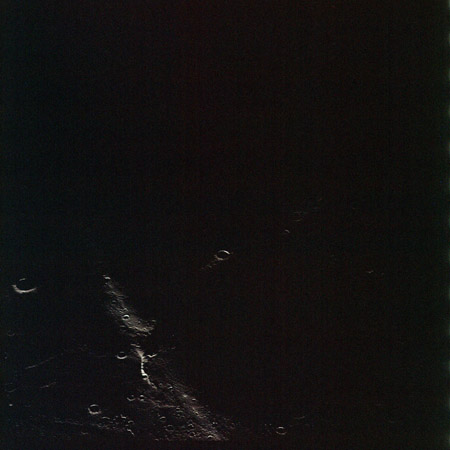
AS15-96-13032 - Lava flows on Mare Imbrium - Image by NASA/Johnson Space Center.
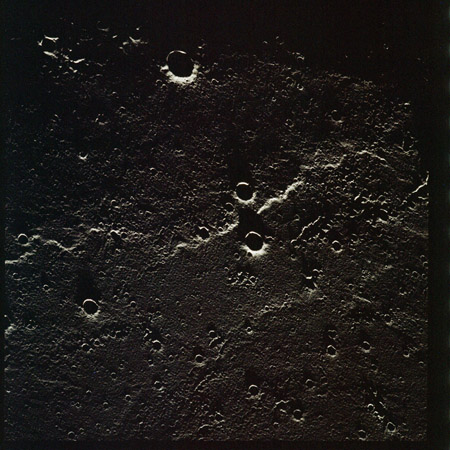
AS15-96-13033 - Lava flows on Mare Imbrium - Image by NASA/Johnson Space Center.
148:11:59 Henize: Al, can you clarify a little more exactly where you're photographing. I see a wrinkle ridge running northwest toward Caroline Herschel from the La Hire Rilles, so this is where I'd guess you're working. Is that correct?
148:12:22 Worden: Negative. That's the large wrinkle ridge running off toward C. Herschel. No, I'm working directly west of La Hire Rilles in that open area out there. Say on a line between Euler and Heis.
148:12:40 Henize: Roger. I copy.
148:12:46 Worden: And there's nothing particularly significant that you can see on the map there. It's just that La Hire Rilles seem to be associated with a lot of those flows, and the flows - there are so many of them, and they're so overlapping and intermingling that I just want to get some general pictures of those flows coming out of La Hire.
148:13:07 Henize: Roger. That sounds like a very interesting region, and I see over by Diophantus there, you've got some very prominent rilles at the present time that probably are just on the - on the terminator, aren't they?
148:13:22 Worden: Yes, Karl. I'm - I'm beyond the terminator now.
148:13:48 Henize: Next time you get the Flight Plan in hand, let me give you the T-start for the zodiacal light photography.
148:14:10 Worden: Okay. Go ahead.
148:14:14 Henize: Okay. 148:34:26 is the zodiacal light photo PAD.
148:14:26 Worden: Understand, 148:34:26.
148:14:29 Henize: That's affirmative. [Long pause.]
148:15:17 Henize: Say again, Endeavour.
148:15:23 Worden: Go ahead.
148:15:26 Henize: Disregard, Al. I thought I heard you call, and it was just something else in the background, I guess.
148:15:35 Henize: Jim is busy drigging [sic] - digging trenches there by the LM, and he just about dug a hole big enough to - to build a swimming pool in. He did a good job. [Long pause.]
148:16:13 Henize: Can you see as far south as the Carpathian Mountains, Al?
148:16:41 Worden: That's negative, Karl. I'm in - I'm - I'm beyond the terminator now in total darkness.
148:16:56 Henize: If you - if your orbit ever brings you far enough south to look at those Carpathian Mountains, I should think that would be pretty interesting. I - well, you probably know better than I, I guess, that's probably an overflow of Procellarum into Imbrium there. Probably sort of - well, if that's true, it should have the appearance of the front edge of a lava flow, although it is a tremendous thing.
148:32:28 Henize: Endeavour, this is Houston. The Rover boys have finished their tasks - most of their tasks with the ALSEP, and they are just now beginning ingress into the LM. Dave managed to get the core drill completely in; and, although he hasn't pulled it out yet, he'll pull it out on the next EVA. The time to set the mission timer, or to set your countdown for the zodiacal light photos is going to be about in one minute. And the word down here is that all of your systems are Go; everything is looking super.
148:33:17 Worden: Roger, Karl. Thank you very much. See you on the other side. And, if you'll check my DSKY, you'll see I got the time count down there too.
148:33:24 Henize: Very good.
148:33:32 Worden: And I'm even managing to finish my lunch. Thank you.
148:33:37 Henize: That is a soft life up there, when you get a chance to finish your lunch.
148:33:45 Worden: You better believe it. Some times it's not so easy.
148:33:52 Henize: I can believe it.
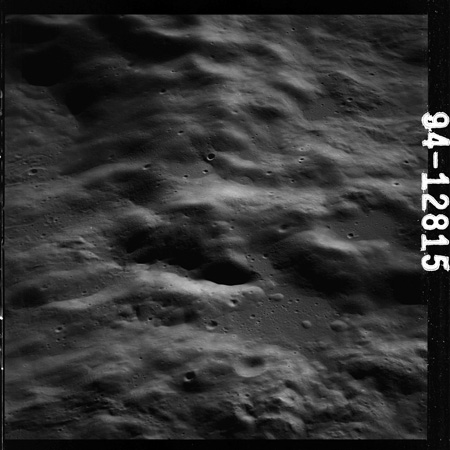
AS15-94-12815 - Crater Waterman, north rim - Image via National Archives.
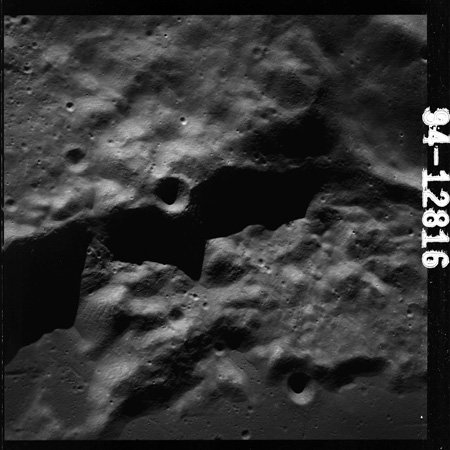
AS15-94-12816 - Crater Tsiolkovsky, west rim - Image via National Archives.
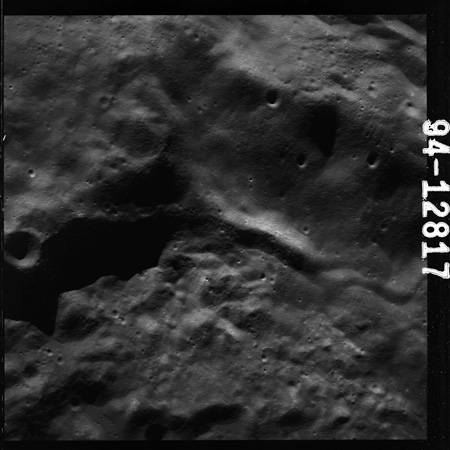
AS15-94-12817 - Crater Tsiolkovsky, west rim - Image via National Archives.
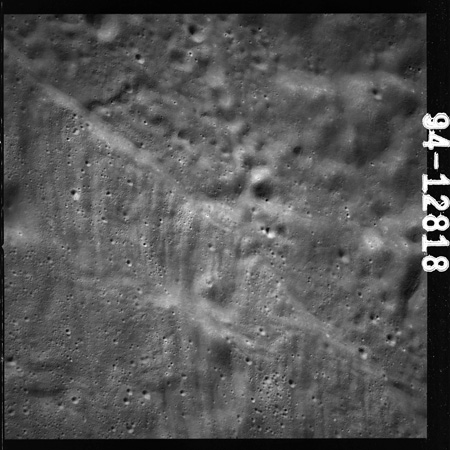
AS15-94-12818 - Lineations northeast of Crater Tsiolkovsky - Image via National Archives.
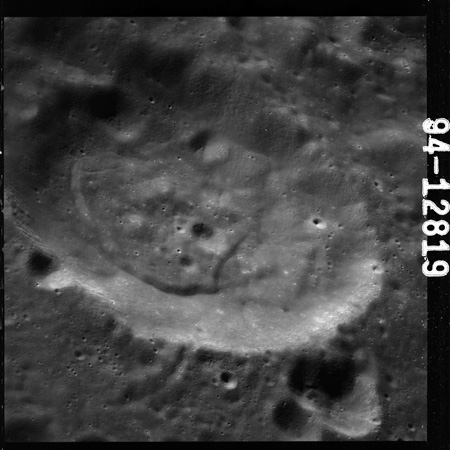
AS15-94-12819 - Crater Lütke and the arcuate feature in its interior - Image via National Archives.
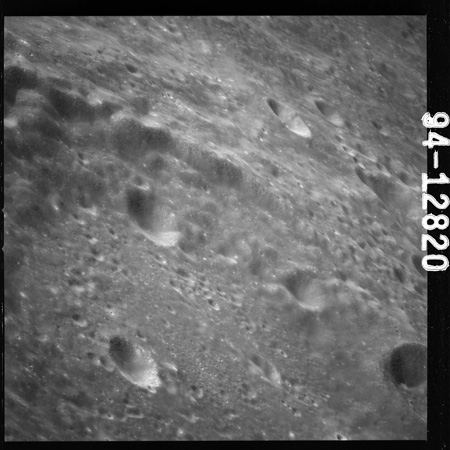
AS15-94-12820 - West side of Crater Meitner - Image via National Archives.

AS15-94-12821 - West rim of Crater Meitner. Einthoven L and Einthoven K at top of frame - Image via National Archives.
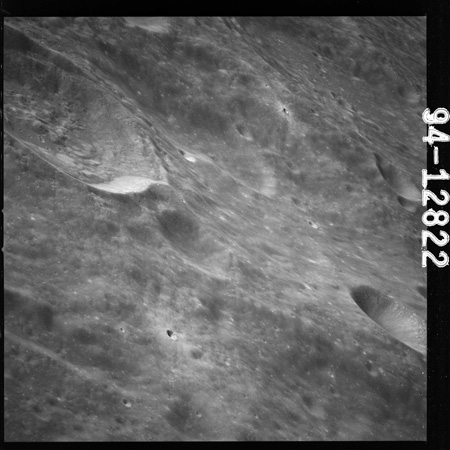
AS15-94-12822 - Crater Pasteur D at top left. Einthoven L at lower right - Image via National Archives.
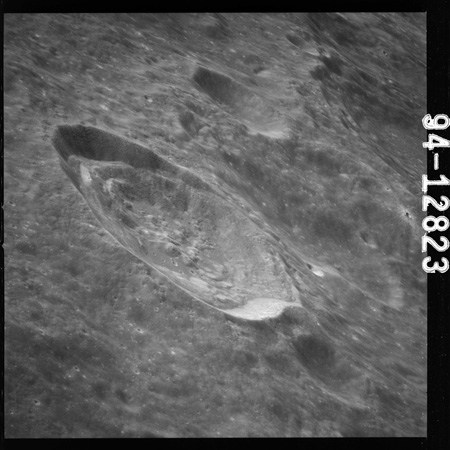
AS15-94-12823 - Crater Pasteur D - Image via National Archives.
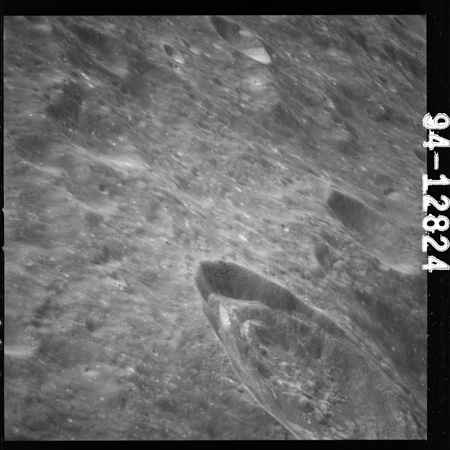
AS15-94-12824 - Crater Pasteur D at lower right. Einthoven P at right of frame - Image via National Archives.
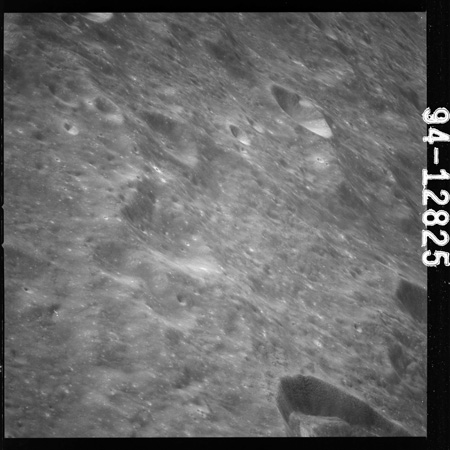
AS15-94-12825 - West rim of Crater Pasteur D at lower right. Einthoven R at upper right - Image via National Archives.
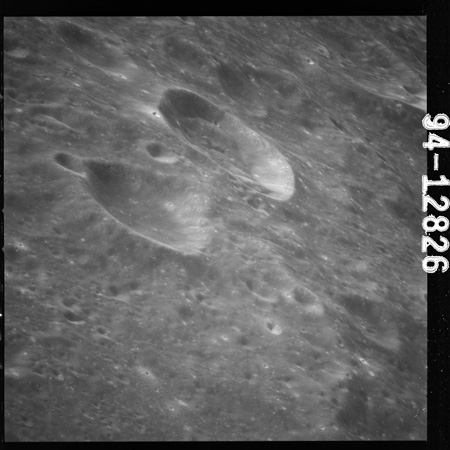
AS15-94-12826 - Craters Pasteur A (upper) and Pasteur B (lower) - Image via National Archives.
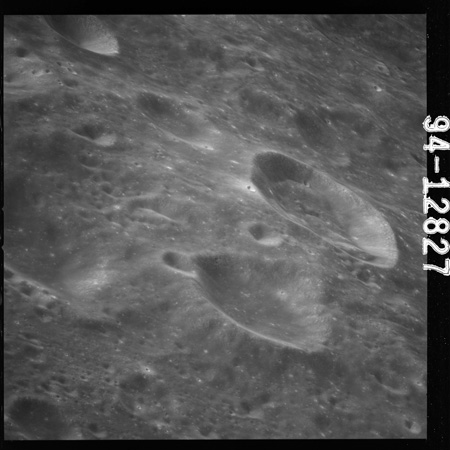
AS15-94-12827 - Crater Pasteur A at right of frame. Pasteur B is lower right. Pasteur Z is upper left - Image via National Archives.
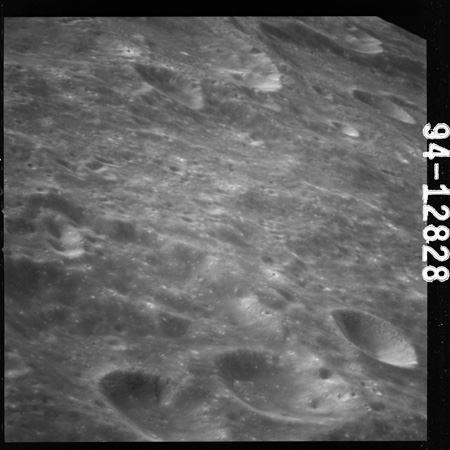
AS15-94-12828 - Crater Pasteur Y dominates the lower left but is indistinct East rim of Saha N is at top of frame - Image via National Archives.
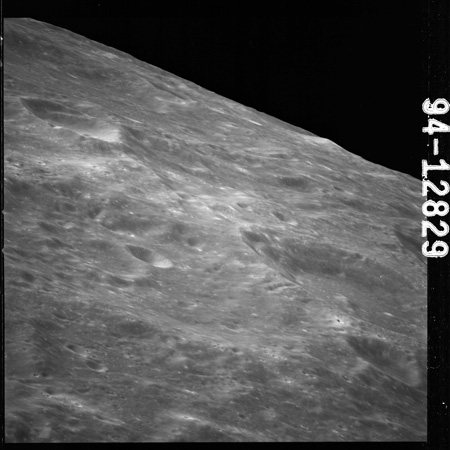
AS15-94-12829 - Crater Saha N is at lower right. Wyld J is at upper left with the larger but less distinct Crater Wyld beyond - Image via National Archives.
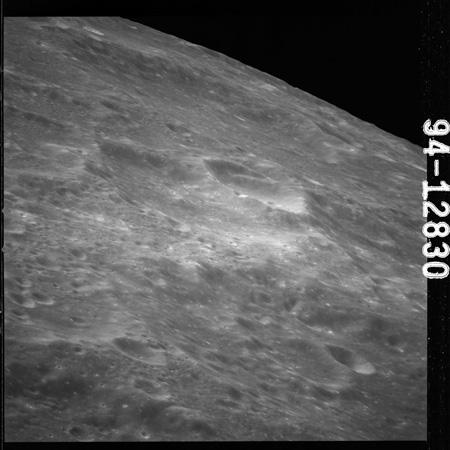
AS15-94-12830 - Crater Wyld J with the larger Crater Wyld beyond - Image via National Archives.
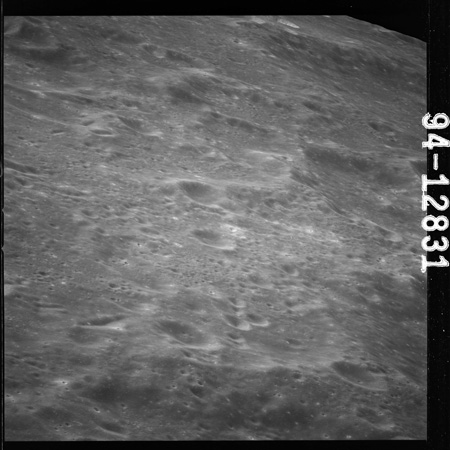
AS15-94-12831 - Western side of Crater Wyld is at upper right - Image via National Archives.
149:27:57 Parker: Endeavour, Houston. Over. [No answer.]
149:28:50 Parker: Endeavour, Houston. How do you read? [No answer.]
149:29:20 Parker: Endeavour, Houston. [No answer.]
149:31:02 Parker: Endeavour, Houston. How do you read? [No answer.]
149:31:29 Parker: Endeavour, Houston. How do you read? [No answer.]
149:32:14 Parker: Endeavour, Houston. How do you read?
149:32:22 Worden: And Houston. Endeavour loud and clear, and I've got you locked up now.
149:32:26 Parker: Roger. I thought you were trying to tell us something.
149:32:35 Worden: Not trying to tell you a thing, Bobby.
149:34:03 Parker: And Al, this is Houston. If you've got a moment, we've got the usual number of little updates to give you.
149:34:14 Worden: Go right ahead, sir. For a change, I'm ready to copy.
149:34:16 Parker: Okay. First of all, we're going to cancel the VHF comm check at 149:37. Your buddies just got into the LM down there, and we don't think they'll be ready, and we won't push them at this time on that.
149:34:32 Worden: Okay. Understand.
149:34:34 Parker: And the second one is, it looks like we'll be delaying your Mapping Camera business at 150:10 in the Flight Plan, and we'll get back to you later on exactly what we'll be doing and when on that. And now if you'll turn to 151 hours, we have a Mapping Camera photo PAD for you.
149:34:58 Worden: Do you mean a Pan Camera photo PAD?
149:35:00 Parker: Negative. It says M - A - P.
149:35:07 Worden: At 151?
149:35:09 Parker: Stand by. [Long pause.]
149:35:30 Parker: Okay, Al, a little explanation. It's a photo PAD I'm due to read you at 150 and 10. You can find the little block there, and it happens that the pass and all that will be taking place on the 151 hour frame. So it's at the 151:10 - 150 and 10 that you'll find the little squares for it.
149:35:50 Worden: Okay. I'm with you. Yes, when you call out a time like that, that's the time I go to the Flight Plan.
149:35:55 Parker: Roger. I thought that's what you should do - but I guess I was wrong. Okay. T-start, 151:09...
149:36:04 Worden: Okay, 150 plus 10?
149:36:06 Parker: Roger. Okay. T-start, 151:09:22; T-stop, 152:09:01. And there's a little note that says at T-start...
149:36:27 Worden: Roger. Understand.
149:36:30 Parker: [Garbled] [Pause.]
149:36:42 Worden: Go ahead with the rest of the PAD, Bob.
149:36:44 Parker: Okay. At T-start, "Mapping Camera Image Motion, Increase, talkback barber pole plus 4". At 151:52:00, "Mapping Camera Image Motion, Increase, talkback barber pole". And then I have a Pan Camera photo PAD, if you're ready to copy that.
149:37:14 Worden: Okay. Let's get this mapping camera straightened out first. T-start is 151:09:22. T-stop, 152:09:01. At T-start, go "Image Motion, Increase, to barber pole plus 4"; at 151:52:00, go "Image Motion, Increase, to barber pole".
149:37:34 Parker: Roger. And this Pan Camera is the one at 151:03 in the Flight Plan.
149:37:43 Worden: Roger. Go.
149:37:45 Parker: Okay. It says T-start, 151:13:13. T-stop, 151:37 to 01. And the next Pan Camera PAD will voiced up [on the] next rev. Over.
149:38:06 Worden: Okay, Bob. Understand. T-start is 151:13:13; T-stop, 151:37:01.
149:38:18 Parker: Roger. Copy. [Long pause.]
149:38:50 Parker: Okay, Al, and another addition is that at 1505 [means 150:05] in the Flight Plan, you'll see some Mapping Camera activities, and you'll find that 150:05.
149:39:09 Worden: Okay, go ahead.
149:39:12 Parker: Roger. And we will move the activities that start with the "Laser Altimeter, On" - that's the third line down in that little block. Move the activities starting with "Laser Altimeter, On", to "Mapping Camera Image Motion, Increase, to [talkback barber pole]/On" which is the last line in that little block. Those will be moved to 151 hours and we will supply you with a T-start later.
149:39:47 Worden: Roger; understand. All items between "Laser Altimeter, On", and "Mapping Camera Image Motion, Increase, to barber pole" should be moved to a GET of 151:00 and you'll supply a start time later.
149:40:13 Parker: And Al, that T-start - turns out I gave to you - is the 151:09:22.
149:40:25 Worden: I see. Convenient, isn't it?
149:40:28 Parker: Well, sort of.
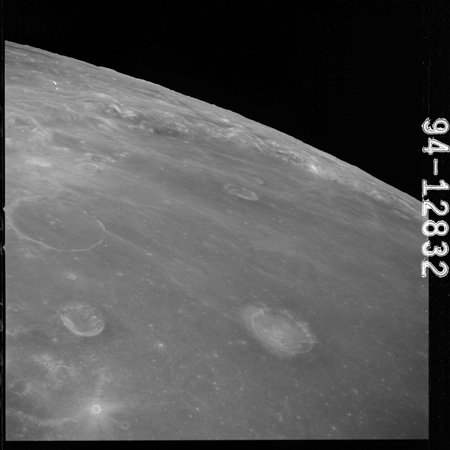
AS15-94-12832 - View north over western Mare Crisium including craters Lick, Greaves, Yerkes, Picard and Peirce - Image via National Archives.
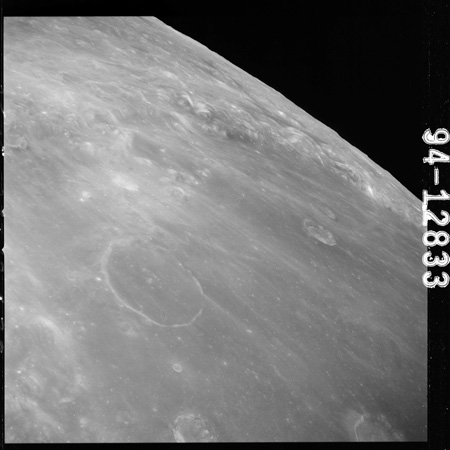
AS15-94-12833 - View north over western Mare Crisium including craters Yerkes, Peirce and Swift - Image via National Archives.
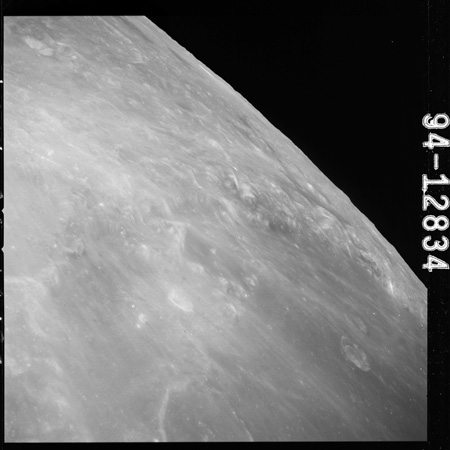
AS15-94-12834 - View north over the western rim of Mare Crisium including crater Peirce and Swift - Image via National Archives.
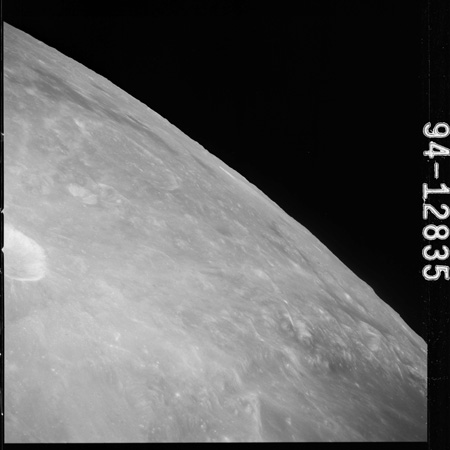
AS15-94-12835 - View north across the highlands west of Mare Crisium. Crater Proclus is at the extreme left - Image via National Archives.
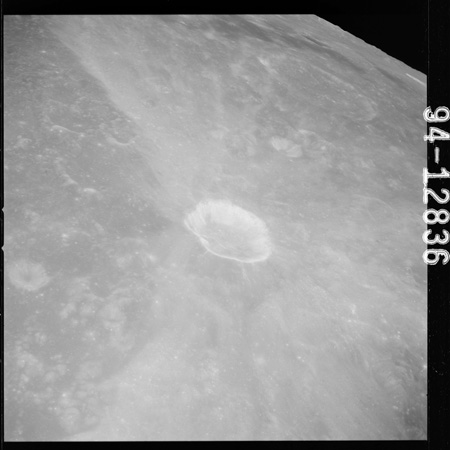
AS15-94-12836 - View north to Crater Proclus with Fredholm and Macrobius beyond - Image via National Archives.
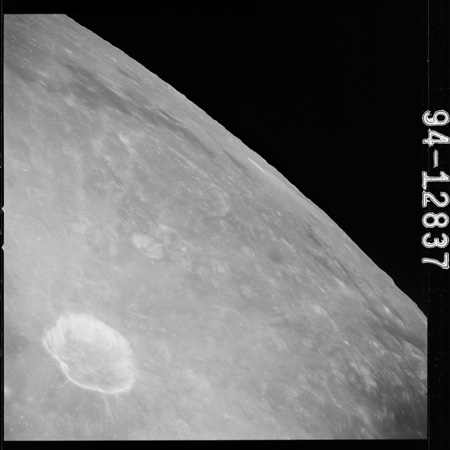
AS15-94-12837 - View north to Crater Proclus with Fredholm and Macrobius beyond - Image via National Archives.
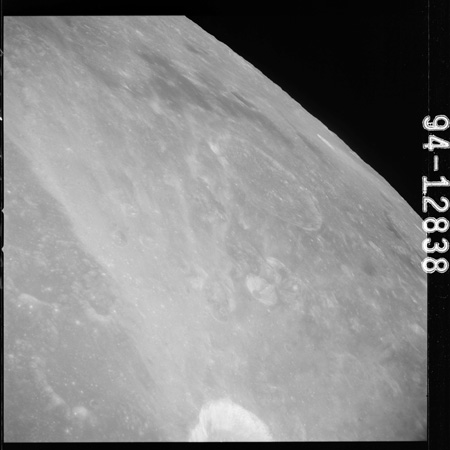
AS15-94-12838 - View north to Crater Macrobius - Image via National Archives.
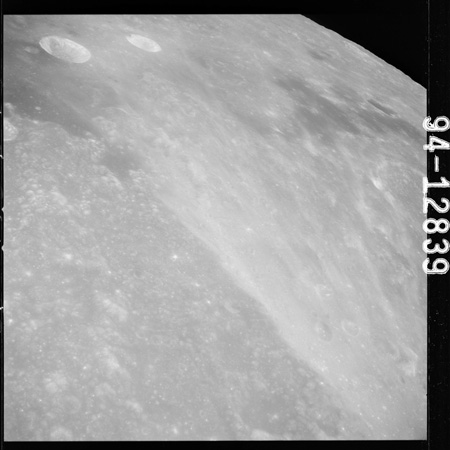
AS15-94-12839 - View north to Lacus Bonitatis, including craters Carmichael and Hill - Image via National Archives.
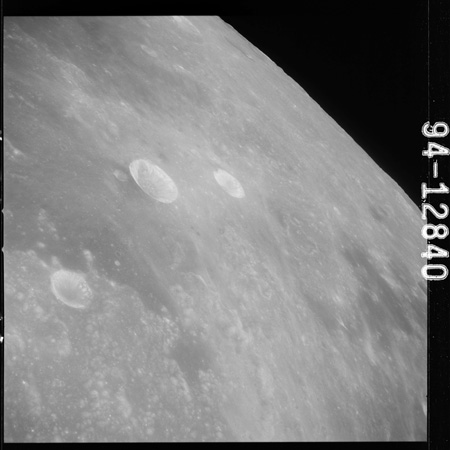
AS15-94-12840 - View north to Sinus Amoris, including craters Carmichael and Hill - Image via National Archives.
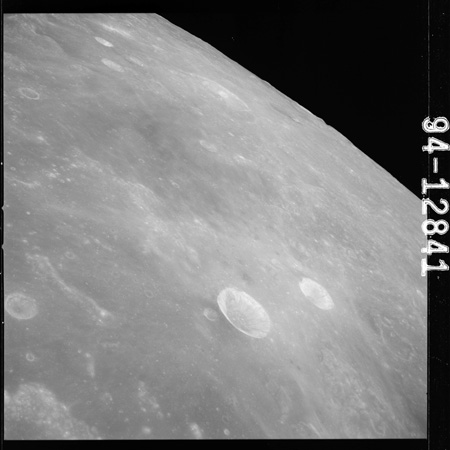
AS15-94-12841 - View north to Sinus Amoris, including craters Carmichael and Hill - Image via National Archives.
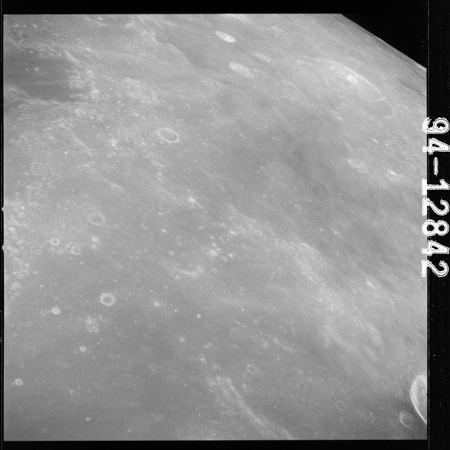
AS15-94-12842 - View north to Sinus Amoris, including craters Römer and Maraldi - Image via National Archives.
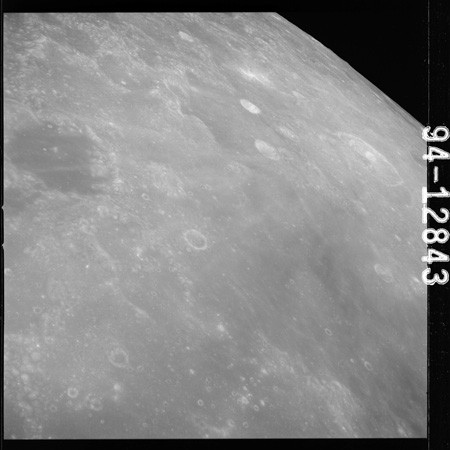
AS15-94-12843 - View north to Sinus Amoris, including craters Römer and Maraldi - Image via National Archives.
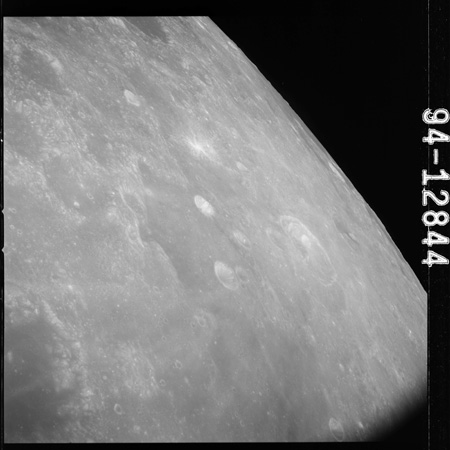
AS15-94-12844 - View north to Sinus Amoris, including craters Römer, Brewster and Franck - Image via National Archives.
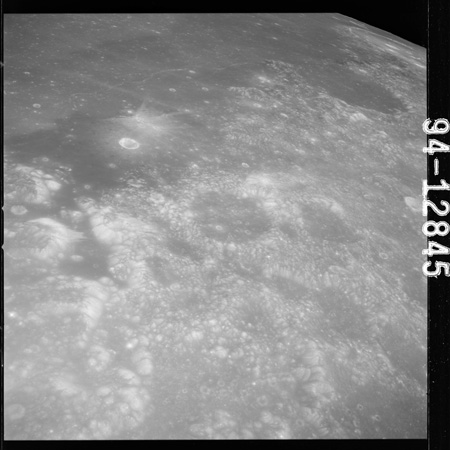
AS15-94-12845 - Montes Taurus and eastern Mare Serenitatis including craters Clerke and Littrow - Image via National Archives.
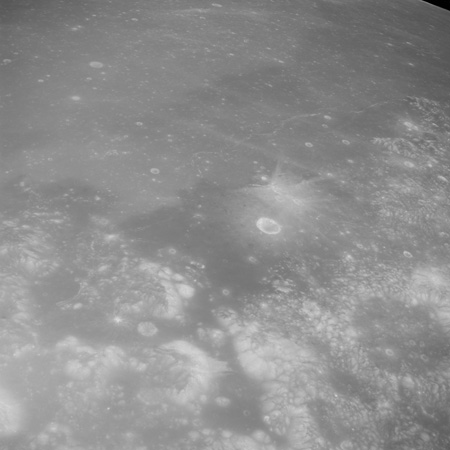
AS15-94-12846 - Montes Taurus and eastern Mare Serenitatis including craters Clerke and Littrow - Image via National Archives.
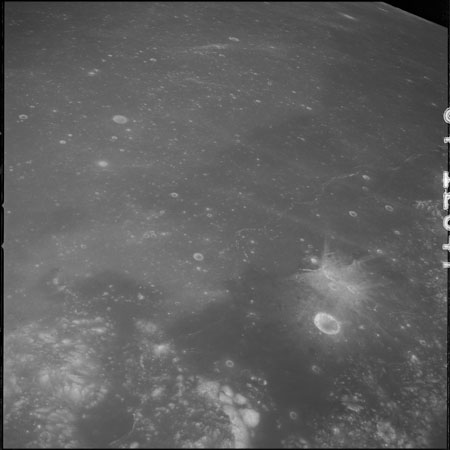
AS15-94-12847 - Montes Taurus and eastern Mare Serenitatis including craters Clerke and Littrow - Image via National Archives.
149:52:57 Parker: Endeavour, Houston. Over.
149:53:02 Worden: Go ahead, Houston; Endeavour.
149:53:04 Parker: Roger. Whenever you got a moment, we've got a few questions the King [Farouk El-Baz] would like to have asked of you concerning your photo activities so far.
149:53:15 Worden: Roger. Go ahead.
149:53:16 Brand: Okay. Hey, Al, Vance here. If you've got a pencil and paper and I'll let you write these things down. Should take about 5 minutes.
149:53:28 Worden: Okay, just a second. [Long pause.]
149:53:47 Worden: Okay, Vance, go ahead.
149:53:49 Brand: Okay. These are going to all refer to your visual sighting targets, and so the first one is V-1B, Tsiolkovsky. You don't need to pull out the book, just - but I'll reference them to pages in the book. First question - or the first comment is, would you mark area on - in your book - on the central peak where you saw layering and when you get back we can look at it?
149:54:29 Worden: Okay, got that one. Go ahead.
149:54:31 Brand: Okay. You spoke of a crater on the north-east side of Tsiolkovsky's rim, and you said it had a fault line. Could you mark that on your map, also?
149:55:01 Worden: Okay. I think I already have, but I'll double check.
149:55:04 Brand: Okay. Next, referring to the - the rim of Tsiolkovsky, you know, the famous sections that appear to be moved inward and outward. The question - Does it appear to you that the west segment of the wall moved inward, or did the northwest segment move outward?
149:55:45 Worden: I think it's just the other way around, Vance, I'll - I'll check it again and mark it on the map next time by; but, as I recall, I think the west section looks like it moved westward.
149:55:56 Brand: Okay. Next, and this would be the V-1A, question 2. We'd just like to have you make sure that you take a look at that one.
149:56:20 Worden: Okay. What's the title on V-1A?
149:56:23 Brand: Okay, that's Tsiolkovsky also. Question 2.
149:56:30 Worden: Oh, I see. Yes, okay. Yes.
149:56:33 Brand: Okay, going to V-2. Referring to Picard, you talked about the layering on Picard wall. Do the layers have a uniform thickness and any estimate of how thick the layers are?
149:56:56 Brand: You might speak of the thickness of the layers in terms of the total depth of the crater.
149:57:06 Worden: In terms of the depth of the crater - or in terms of the diameter of the crater?
149:57:11 Brand: Well, either way - [whatever is] most convenient with you.
This is Apollo Control at 151 hours, 47 minutes. In about five minutes, the Command Module with Al Worden aboard, will be coming within VHF range of the Lunar Module and the two crew - crews plan to attempt to make VHF contact. They will be within VHF range from about 151 hours, 51 minutes until about 152 hours, 4 minutes; or about 13 minutes. In our last conversations with Al Worden, we got a status from him on the performance of the camera equipment, sensors in the Scientific Instrument Module bay of the Service Module and Worden reported that the cameras are functioning very well. We do have a couple of relatively minor problems at this point in the SIM bay. The boom which deploys the Mass Spectrometer out a distance of about 24 feet [7.3 metres] from the mold line of the Service Module appears to be binding up possibly when retracted. At least we've noticed that when retracting the Mass Spectrometer on the boom, it is retracting more slowly than we would expect. Since we're not in the most favourable attitude at the present time for use of the Mass Spectrometer, which gathers information on the lunar atmosphere, we plan to delete extending the Mass Spectrometer this evening and - to assure that we do have a fully operational instrument later in the flight when the Command Module will be in a more favourable attitude to obtain this kind of information. Also the Laser Altimeter, which is used in conjunction with the Mapping Camera, does not appear to be providing useable altitude data. We've been observing this and it was thought that perhaps when the SIM bay reached the proper temperature and the instruments there had cooled down to the proper point, that the altimeter would begin working. However, we do not have - or are continuing to get no useable data from the altimeter and are beginning to reach the conclusion that perhaps we're not going to get Laser Altimeter data. This is not particularly serious. It's one very useful piece of information which we would like to have on the Mapping Camera. This - this altimeter provides an altitude reference on each frame that is shot with the Mapping Camera allowing mapmakers, who will be working with the photographs following the mission, to determine the precise altitude of a particular point on the photograph, and from that to calculate the altitudes of other - other features in the photo frame. We're now about one minute away from the scheduled time at which the Command Module will reach VHF acquisition with the Lunar Module. And you heard Dave Scott a while ago say that he did plan to try to get in some communications with Al Worden aboard the orbiting Command Module. So we'll stand by for that.
We have about 12 minutes left now before we reacquire Al Worden in the orbiting Command Module Endeavour. And at the present time, we show Endeavour in an orbit 65.7 by 51.4 nautical miles [121.7 by 95.2 km].
We've just had Acquisition Of Signal, reestablishing radio contact with Al Worden aboard the Command Module. This will be the last revolution of the Command Module before Worden begins his rest period. And since we've said goodnight to the crew aboard Falcon, we plan to carry the - and air-to-ground conversations live with the Command Module. We'll tape any conversations that we have with the Lunar Module although we would not expect any. and play those back shortly after receiving them. So at this time we'll pick up and stand by live for any conversations with Al Worden aboard the orbiting Command Module Endeavour.
This is Apollo Control at 154 hours, 4 minutes. We said goodnight to Al Worden aboard the Command Module at 153 hours, 54 minutes, or - correction, one hundred - fifty - yes, 153 hours, 54 minutes, or about 8 or 9 minutes ago. And we last heard from Scott and Irwin aboard Falcon on the lunar surface at 153 hours, 15 minutes, which was about 1 hour, 50 minutes beyond their scheduled beginning of the rest period. The surgeon reports that heart rates indicate that Irwin, on whom we have biomedical data, is beginning to get to sleep, although at the present time, he's not sleeping soundly but the heart rates are coming down indicating that he's beginning to drop off to sleep. The fact that Scott and Irwin did get to sleep - or begin their rest period 1 hour and 50 minutes late, and this coupled with the fact we have rigid ingress time, a time for the crew to reenter the Lunar Module and prepare for liftoff. That time is about 168 hours. This coupled with the late beginning to the rest period implies that we'll probably have a late start to the third EVA. We do not plan to put in a call to the crew until they've had 7 hours of rest and this would mean that we would start the EVA - start the preparations for the EVA 1 hour, 50 minutes late. We would hope to make up at least part of that in the EVA preparations and our best estimate at this time is that the EVA, the third ExtraVehicular Activity, will be shortened by somewhere between 1 hour to 1½ hours, starting 1 to 1½ hours later than the scheduled Flight Plan time, or at about 163 hours to 163 hours, 30 minutes. However in the final analysis, this will depend on when the crew, Scott and Irwin, awake and get started on their EVA preparations. In order to be prepared for any eventuality, we're planning the EVA for 4 to 6 hours or anything in between. The best estimate at this time is that it would be a 5-hour EVA getting started about 1 hour late. Since we do not expect any further conversations with the Command Module or the Lunar Module during the rest periods, we plan to take the lines down. Should we hear anything from either vehicle, we'll play back the conversation immediately on tape and then stand by live if it appear there'll be any further conversations. At 154 hours, 7 minutes; this is Apollo Control, Houston.

